The FAO is projecting continued Ontario budget deficits over the next five years. For 2017-18, the FAO’s projection includes an improvement in the deficit, the result of a $3.0 billion one-time boost to non-tax revenue and strong tax revenue growth. However, beginning in 2018-19, the FAO is projecting a steady deterioration in the budget deficit due to moderating revenue growth combined with higher expenses.
The government and the Auditor General continue to disagree on the application of public sector accounting standards for jointly-sponsored pension plans.[1] Based on the FAO’s application of the Auditor General’s recommended accounting treatment for these pension assets, the FAO is projecting significant budget deficits over the entire outlook. On this basis, it is unlikely that the government will balance the budget without significant fiscal policy adjustments to raise revenue or lower expense.
Under the government’s accounting presentation, the FAO projects that a balanced budget is within the government’s reach in 2017-18. Beyond 2017-18, the deficit is projected to deteriorate steadily due to rising expenses and moderate revenue growth. On this basis, staying in balance after 2017-18 will likely require additional fiscal policy measures. This presentation of Ontario’s fiscal position would be expected to receive a qualified opinion from the Auditor General when published in the Province’s 2016-17 Public Accounts.
Ontario’s Budget Balance*
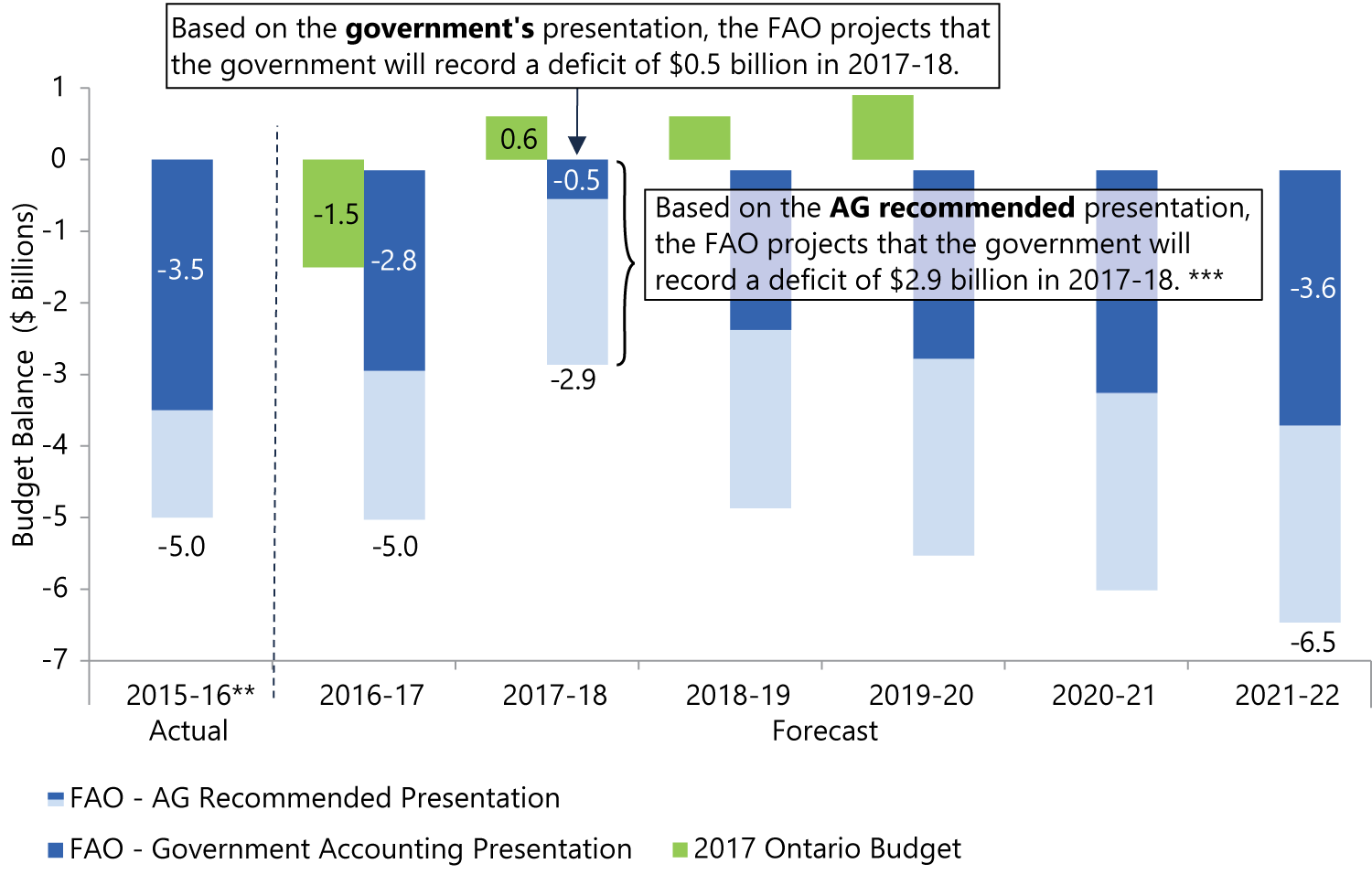
* Budget balance before reserve.
** Ontario’s 2015-16 Public Accounts reported a deficit of $5.0 billion. Without the pension adjustment, the deficit would have been $3.5 billion.
*** This includes the FAO’s estimate of the pension adjustment.
Source: 2015-16 Public Accounts, 2017 Ontario Budget and FAO.
The FAO’s economic outlook expects the recent strength of the Ontario economy to continue into 2017. The FAO is forecasting solid growth in real GDP of 2.4 per cent in 2017, moderating to an average annual pace of 2.0 per cent over the following four years. The FAO’s economic forecast is broadly in-line with that presented in the government’s 2017 Budget.
However, there are significant risks that could result in weaker than expected economic growth for Ontario. In particular, the policy direction of the new U.S. administration remains uncertain. This could hamper business investment and Ontario’s economic prospects. Domestically, Ontario’s surging housing market continues to be the largest risk for the economy. A sharp correction in housing prices could reverberate beyond the housing market and lead to broader, economy-wide impacts.
Consistent with the economic outlook, the FAO is projecting total revenues will rise by 3.3 per cent per year over the outlook. This reflects the FAO’s forecast for solid growth in tax revenues combined with a significant one-time increase in non-tax revenues in 2017-18, including the sale of public sector assets. The FAO projects annual program spending growth to average 3.3 per cent per year over the outlook, a rate slightly below underlying spending pressures.
Given on-going deficits and projected capital spending, the FAO is forecasting Ontario’s net debt will increase by $76 billion over the next five years, under the Auditor General’s recommended accounting presentation. On this basis, Ontario’s net debt-to-GDP ratio will edge higher to 40.3 per cent by 2021-22.
In the 2017 Budget, the government set an interim net debt-to-GDP target of 35 per cent by 2023-24 and committed to achieving 27 per cent by 2029-30. Given the FAO’s projection of rising deficits and the government’s planned capital investments over the outlook, achieving these debt targets will likely require significant additional fiscal measures.
Ontario’s Net Debt-to-GDP Ratio
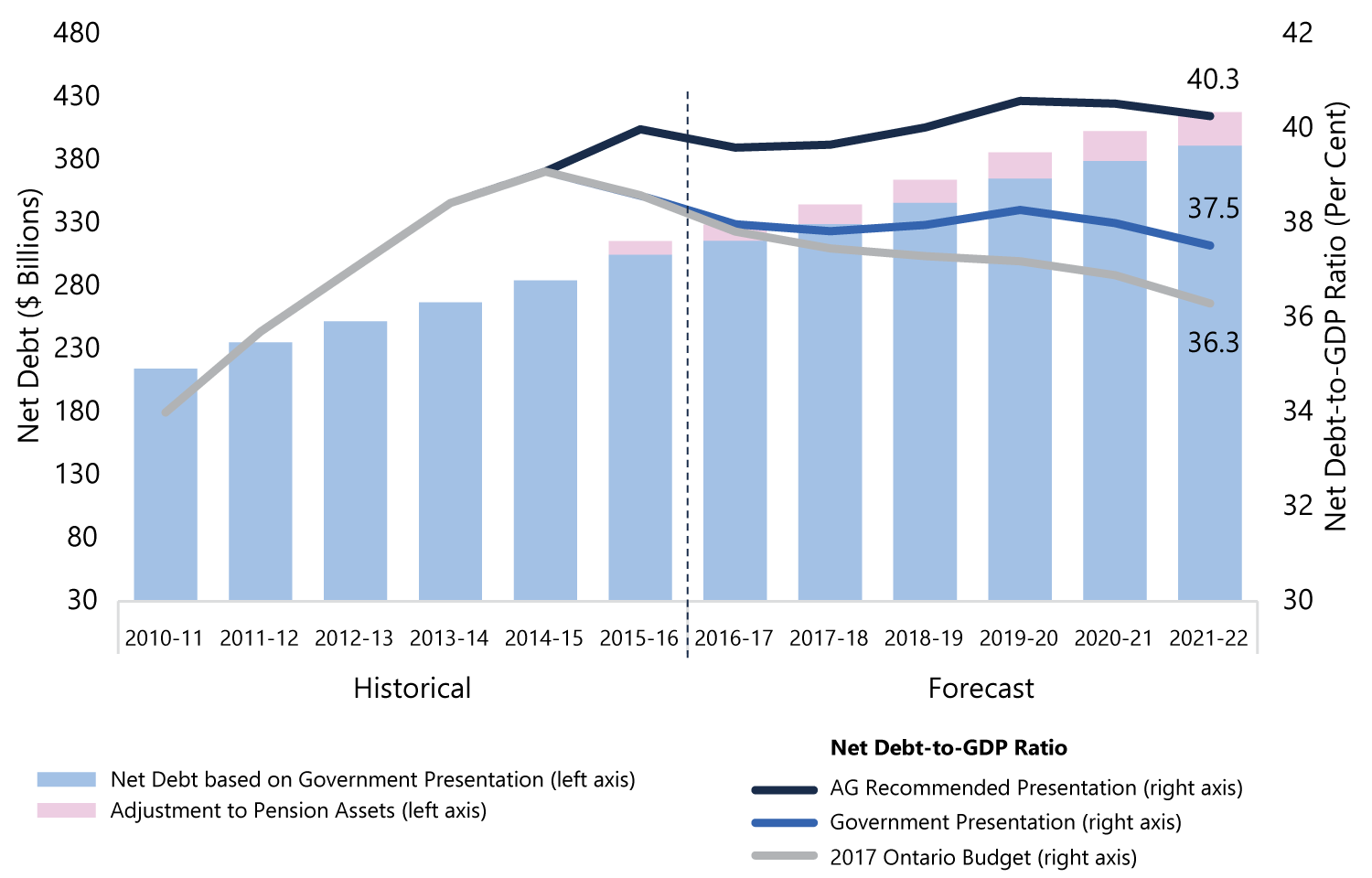
Source: Ontario Economic Accounts, 2017 Ontario Budget, and FAO.
Note: AG recommended presentation based on FAO estimates of the pension adjustment.
Overview
Ontario Economy Expected to Remain Strong in 2017
The Ontario economy finished 2016 with a strong 2.7 per cent increase in real GDP, reflecting solid growth in the second half of the year. Real GDP growth last year was significantly above the 2.1 per cent average gain seen from 2011 to 2015. Strong household spending, residential investment and exports contributed to the increase in real GDP in 2016.
Supported by the strong economic momentum in 2016 and continued improvement in economic indicators in the first quarter of 2017, the FAO is projecting real GDP to rise by 2.4 per cent in 2017 and 2.1 per cent in 2018.
Nominal GDP – the broadest measure of the tax base – increased by a robust 4.6 per cent in 2016. The FAO is projecting nominal GDP to increase by 4.1 per cent in 2017 and 4.2 per cent in 2018, reflecting solid gains in labour income and corporate profits.
Solid Economic Performance Expected Over Outlook
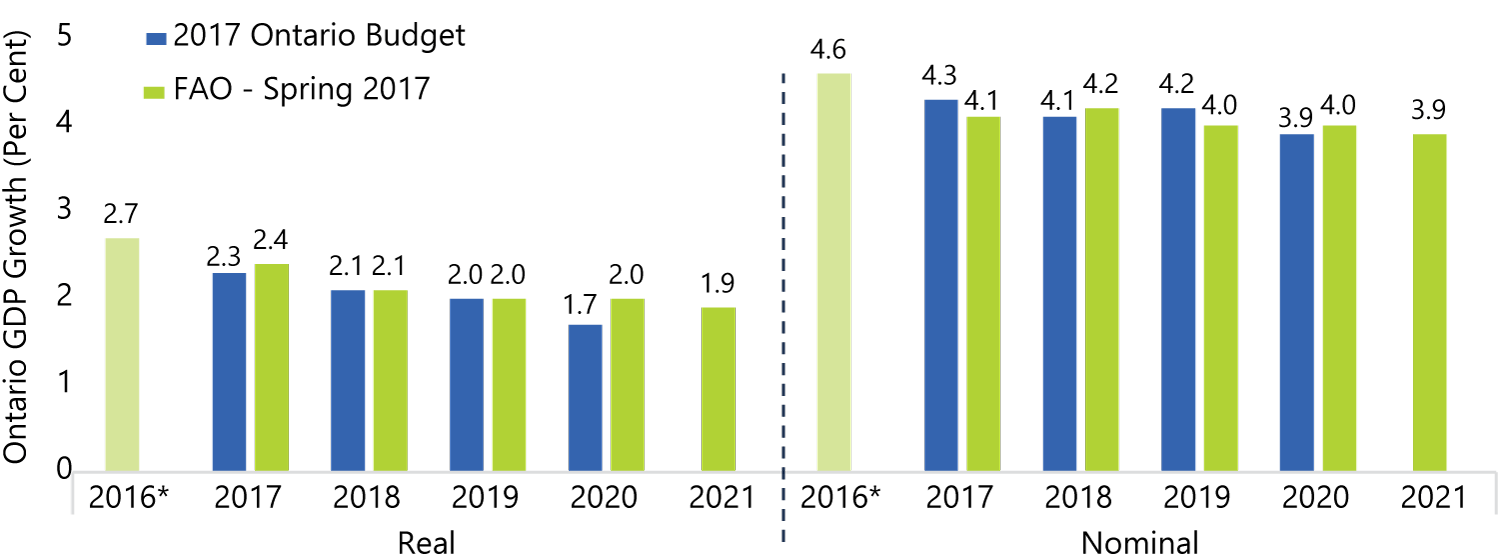
* 2016 are actuals.
Source: Ontario Economic Accounts, 2017 Ontario Budget and FAO.
Global Economy Gaining Momentum
In its latest World Economic Outlook,[2] the International Monetary Fund (IMF) is forecasting global economic growth to strengthen from 3.1 per cent in 2016 to 3.5 per cent in 2017 and 3.6 per cent in 2018. The IMF revised the outlook slightly higher for 2017, but left it unchanged for 2018, compared to its October 2016 outlook.[3]
For advanced economies, the IMF’s forecast for 2017 and 2018 has improved slightly from its October projection with growth of 2.0 per cent in 2017 and 2018.
Growth prospects for emerging market and developing economies are much more varied, but overall have weakened slightly from the IMF’s October outlook, due to weaker economic conditions in key export markets. On average, the IMF has lowered its growth forecast for emerging markets and developing countries to 4.5 per cent in 2017, with 2018’s forecast remaining unchanged at 4.8 per cent.
The IMF expects China – the world’s second largest economy – to grow by 6.6 per cent in 2017 and 6.2 per cent in 2018, reflecting continued support from government policy. In the medium term, China’s economic growth is expected to gradually moderate as its economy rebalances from investment and manufacturing-led growth to a more service-intensive economy.
Global Growth to Improve in 2017

Source: “World Economic Outlook, Gaining Momentum?”, April 2017, International Monetary Fund.
U.S. Economic Growth to Strengthen in 2017
U.S. real GDP advanced by a relatively moderate 1.6 per cent in 2016, the weakest increase in three years. For 2017 and 2018, the FAO projects U.S. growth to improve to 2.3 per cent, with household spending, business investment and residential construction being key contributors to overall growth.[4]
However, the lack of specific details on the new U.S. administration’s proposed policies has raised the risks associated with the current U.S. outlook. Many forecasters are cautiously optimistic that some of the proposed fiscal policies, such as expected cuts to corporate tax rates, could boost U.S. economic growth in the short-term.[5] But this optimism is tempered by the potential for large future increases in the U.S. budget deficit, which could weigh on economic growth over the medium-term.
From 2019 to 2021, U.S. real GDP growth is projected to average 2.1 per cent annually, which is in-line with the average rate seen from 2012 to 2016.
U.S. Economic Growth Moderates Beyond 2017
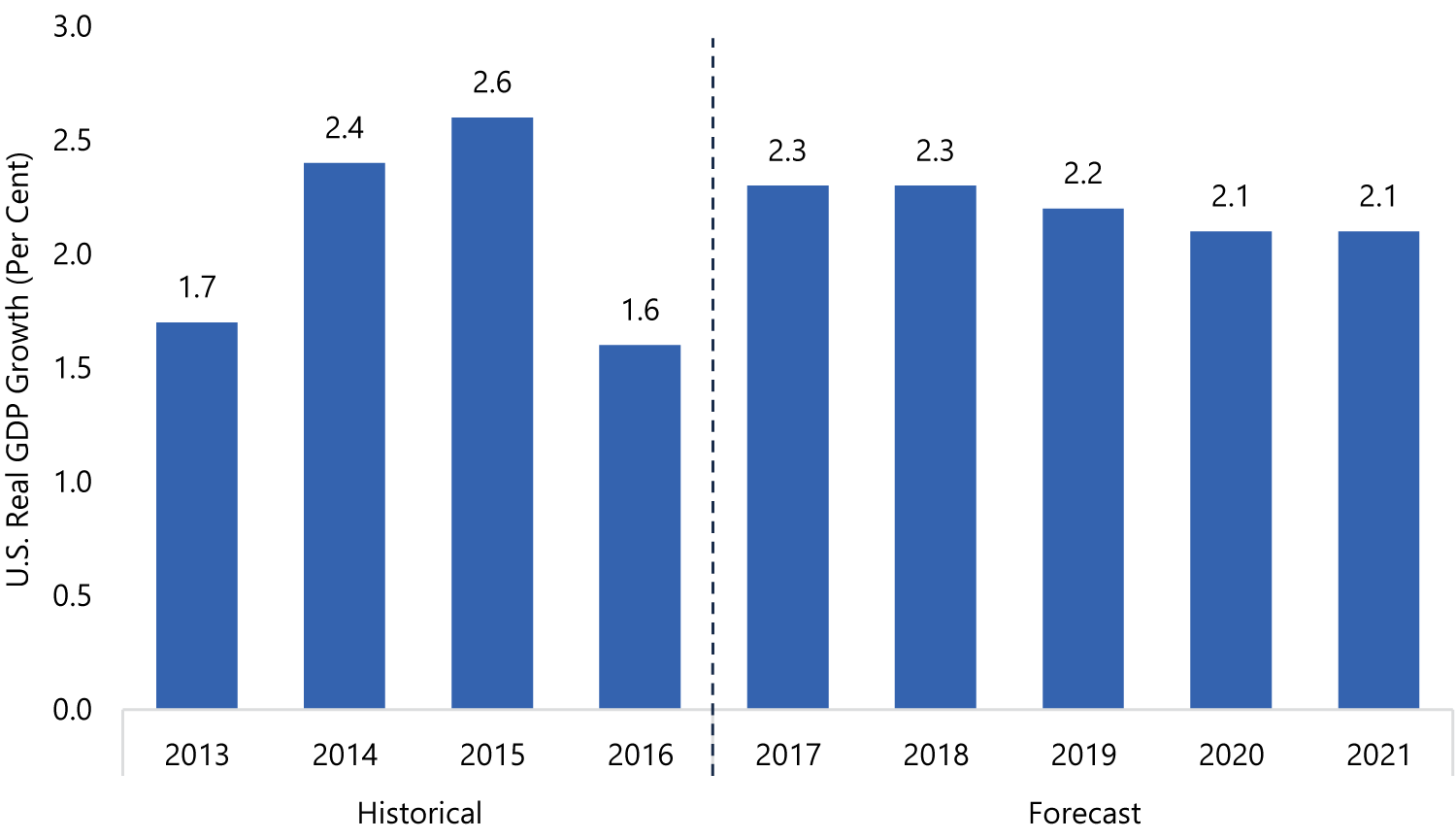
Source: Federal Reserve Bank of St. Louis, Congressional Budget Office and FAO Consensus.
Canadian Economic Growth Expected to Rebound
The outlook for the Canadian economy has improved following strong growth over the second half of 2016.
Continued momentum in recent economic indicators point to a solid start for 2017. Canadian real GDP is currently projected to grow by 2.2 per cent in 2017 and 2.3 per cent in 2018, recovering from more moderate growth in 2015 and 2016.[6] Strength in household spending and non-energy exports are expected to contribute to overall growth in 2017 and 2018.
Beyond 2018, Canadian real GDP is projected to increase at an average annual rate of 2.0 per cent, as the economy continues to adjust to slower growth in the energy sector.
Canada GDP Growth Expected to Improve in 2017
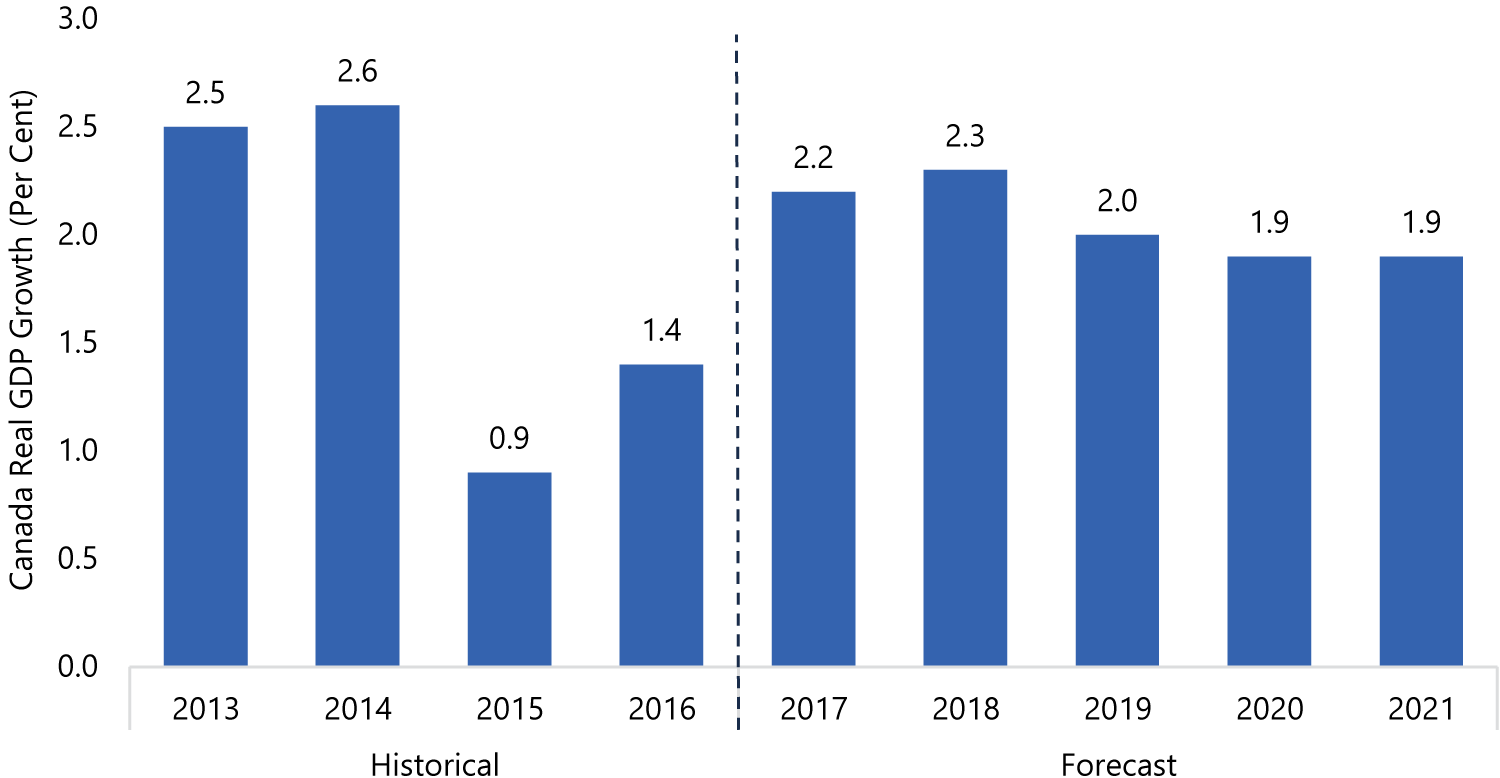
Source: Statistics Canada and FAO Consensus.
Based on the continuing recovery of the U.S. economy, and in particular the strength of U.S. labour markets, the U.S. Federal Reserve raised its key policy interest rate in March 2017.[7] In contrast, the Bank of Canada has remained more cautious about the underlying strength of the Canadian economy and as a result appears unlikely to raise its key policy interest rate before 2018.[8]
The FAO is projecting Canadian short-term interest rates will remain near current levels through 2017 and then begin rising modestly in 2018. Beyond 2018, interest rates are expected to gradually normalize with the 3-month Treasury Bill rate increasing to 2.6 per cent and the 10-year Government of Canada bond yield rising to 3.9 per cent by 2021.
Canadian Interest Rates to Rise over the Forecast
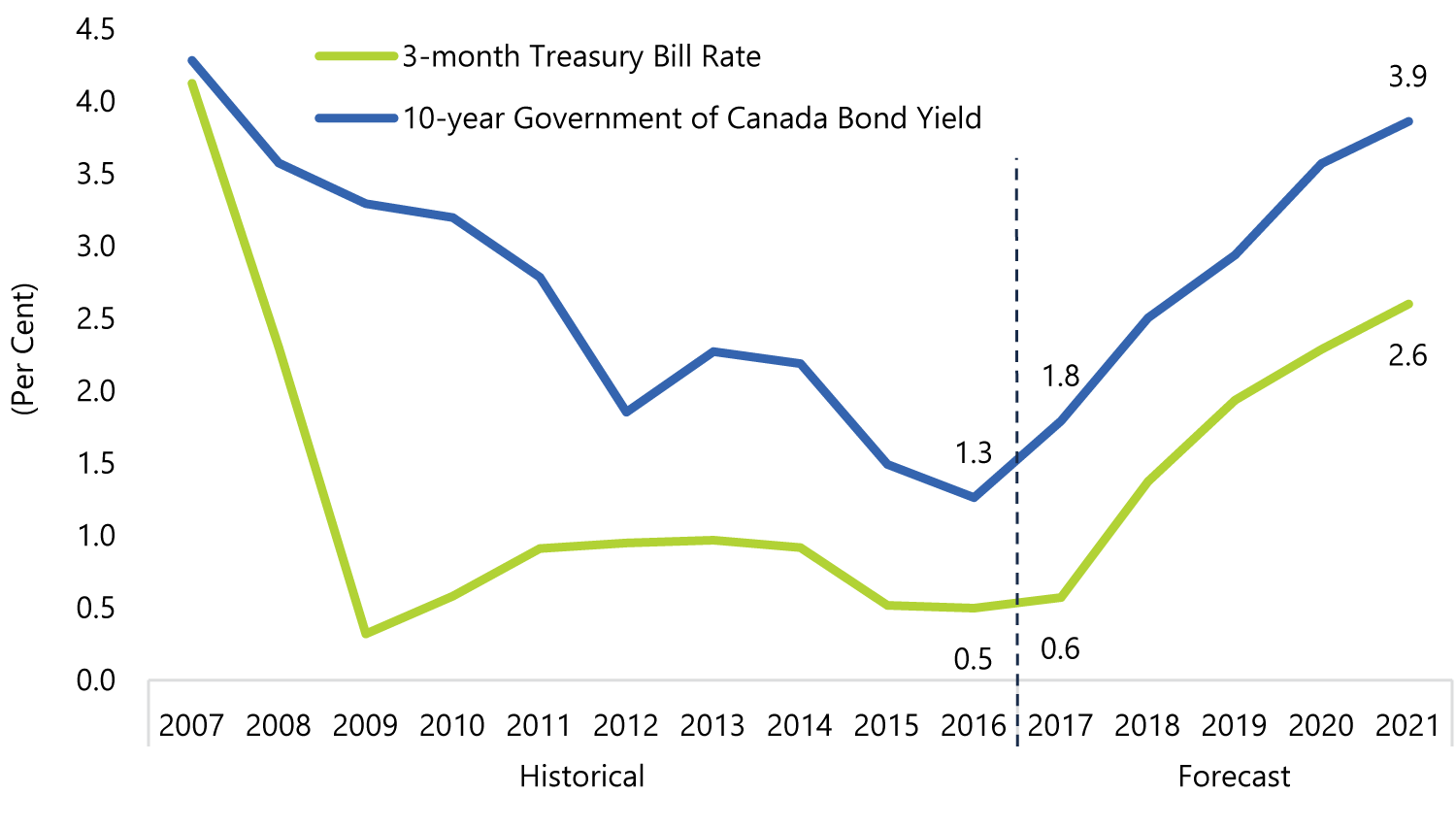
Source: Statistics Canada and FAO.
The Canadian dollar is expected to gradually appreciate over the next five years, rising from an average of about 75 cents U.S. in 2016 to about 81 cents U.S. by 2021, supported by the steady increase in short-term interest rates and a gradual rise in oil prices.
Ontario Economic Outlook
Solid Real GDP Growth Expected in 2017
Based on the Ontario Ministry of Finance’s estimates,[9] Ontario real GDP rose by a strong 2.7 per cent in 2016, following equally strong gains of 2.5 per cent and 2.7 per cent in 2015 and 2014, respectively. Household spending, residential investment and exports were key contributors to overall economic growth last year. Business investment in plant and equipment disappointed expectations, declining by 4.0 per cent.
The performance of a number of economic indicators, including employment, retail sales and home sales remained solid in the first quarter of 2017. However, Ontario’s merchandise export performance has been uneven so far in 2017.
Uncertainty over the future direction of U.S. trade and industrial policy could hamper business investment growth in the near term, which would negatively impact Ontario’s competitiveness. Without stronger business sector investment to expand production capacity, the growth potential of several key Ontario industries will be limited.[10] As a result, despite the projection for steady growth in the U.S. and a competitively valued Canadian dollar, Ontario’s net exports[11] are projected to grow at a relatively moderate pace over the outlook.
The FAO is forecasting real GDP growth of 2.4 per cent in 2017, supported by strong household spending and residential investment.[12] The pace of Ontario’s overall economic growth will moderate to 2.1 per cent in 2018 and to an average of 2.0 per cent over the last three years of the outlook.
Moderate declines in residential investment in 2018 and 2019 – reflecting elevated household debt and a moderation in housing prices – is expected to contribute to the slower pace of overall economic activity.
The FAO forecast is broadly consistent with the consensus view among economists that exports and business investment will lead Ontario growth over the next several years, while household spending and residential investment will grow at a more moderate pace, as households reduce borrowing to address high debt loads.
Exports and Business Investment Expected to Drive Economic Growth
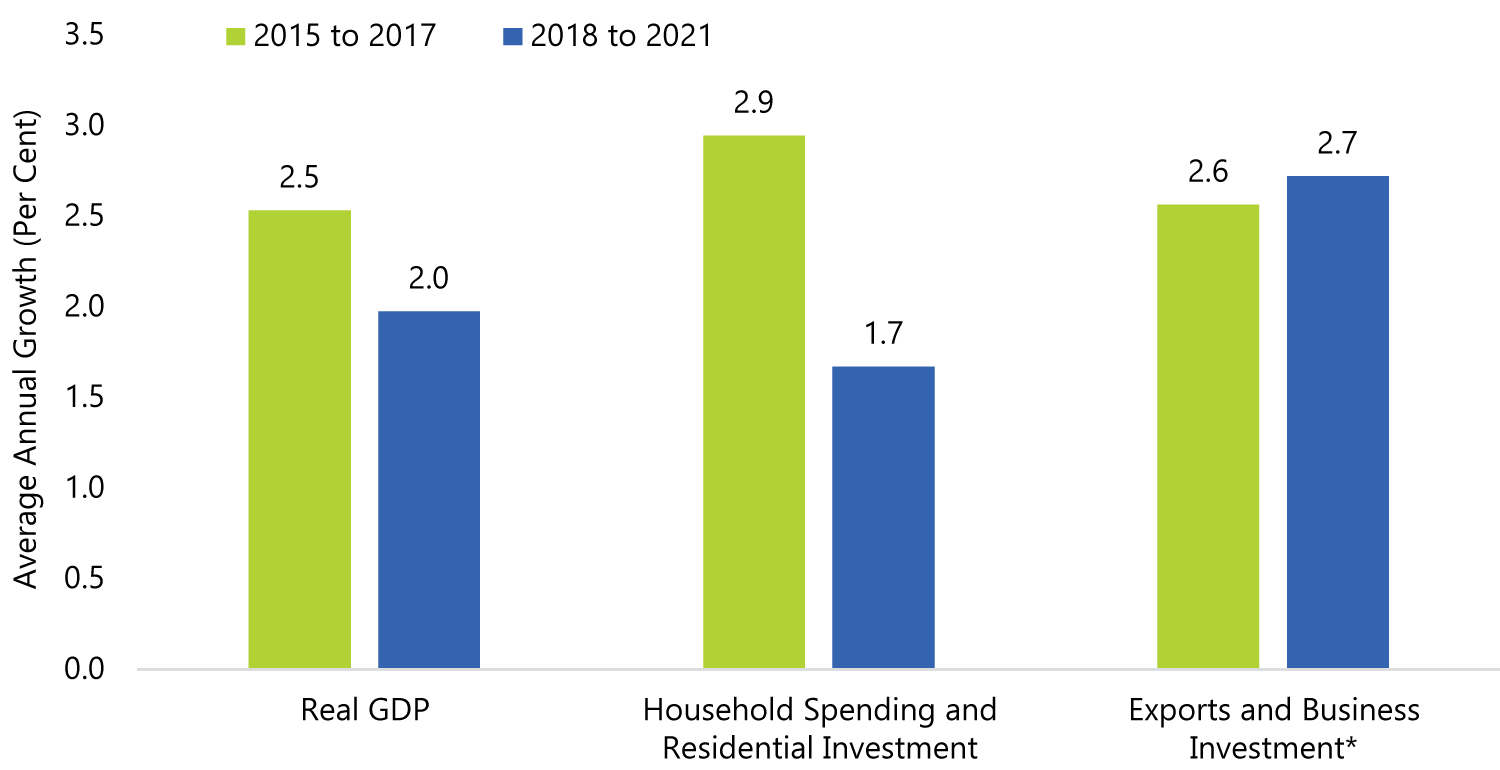
* Business Investment includes both Non-Residential Investment and Machinery & Equipment Investment.
Source: Ontario Economic Accounts and FAO.
Steady Job Gains Over Outlook
Ontario experienced relatively strong employment growth of 1.1 per cent in 2016 (+76,400 net new jobs), the majority of which were full-time, private sector jobs. There was robust job growth in both goods and service producing industries. The construction industry in particular, posted the highest job growth (+3.4 per cent), followed by healthcare (+3.2 per cent).[13]
The strength in Ontario’s labour market continued into 2017 with an increase of 99,600 jobs on a year-over-year basis during the first quarter. For the year, the FAO is projecting a 1.3 per cent gain in employment in 2017. On average, the FAO is forecasting average annual job gains of 1.0 per cent over the next four years, consistent with the outlook for solid economic growth.
Steady Employment Gains as Unemployment Rate Slowly Trends Lower

Source: Statistics Canada and FAO.
Sustained economic growth over the outlook is expected to attract more workers into the labour force, which is forecast to rise at a slightly higher rate than over the last five years. Faster labour force growth from 2017 to 2021, will partially offset relatively strong employment gains, leading to a more moderate decline in the unemployment rate over the outlook.
Strong Gains Expected for Labour Income and Corporate Profits
Labour income grew by a robust 4.2 per cent in 2016, above the average annual increase of 3.7 per cent from 2011 to 2015, and a reflection of the strong employment growth last year. The net operating surplus of corporations (largely corporate profits) also increased by a robust 9.2 per cent in 2016 following an equally strong gain of 9.1 per cent in 2015.
As a result of the gains in labour income and corporate profits (which together account for about two-thirds of nominal GDP), nominal GDP grew by a strong 4.6 per cent in 2016.[14]
For 2017, the FAO is projecting a 4.1 per cent rise in nominal GDP, supported by strong gains in labour income (+4.0 per cent) and corporate profits (+6.0 per cent). On average, the FAO is projecting nominal GDP growth of 4.0 per cent over the 2018 to 2021 outlook.
Labour Income and Corporate Profits Support Nominal GDP Growth

Source: Ontario Economic Accounts and FAO.
Key Risks for Ontario’s Economic Outlook
The FAO’s current economic forecast represents a reasonable outlook for the Ontario economy and an appropriate foundation for fiscal projections. However, several key risks could materialize leading to weaker than expected economic growth for the province.
In particular, there are significant risks with respect to the proposed renegotiation of the North American Free Trade Agreement (NAFTA) and the adoption of protectionist trade measures in the United States. As well, other proposed changes to U.S. fiscal and industrial policies, such as lower corporate tax rates and ‘Buy America’ executive orders, could harm Ontario’s relative competitiveness, further discouraging business investment and limiting the contribution of exports to overall growth.
Domestically, the housing market continues to pose a significant risk to the overall economy. The sharp rise in Ontario housing prices – particularly in the Greater Toronto Area – has contributed to record consumer debt loads and stretched levels of affordability.
At the same time, the relative importance of residential housing investment to the overall economy has increased substantially in recent years, posing a significant risk to the Ontario economy, in the event of a sharp housing market correction. In 2016, investment in residential housing accounted for a record high 8.3 per cent of Ontario’s nominal GDP, up from 6.4 per cent in 2009.[15]
Residential Investment Spending Accounts for a Record Share of GDP

Source: Ontario Economic Accounts and FAO.
The last time investment in residential housing accounted for a similar proportion of the economy was 1989, just prior to the 1990-1995 housing market correction.
A sharp correction in housing prices, exacerbated by the elevated levels of household debt, would negatively affect household spending and residential investment, and could lead to broader economy-wide impacts on growth and employment.
The Province recently announced a package of measures intended to respond to the underlying factors contributing to the unsustainable rise in housing prices and the rapid growth in housing market activity. However, it is too early to assess whether these measures will adequately address the imbalance between demand and supply pressures in the market.
The FAO’s Quarterly Short-term Model of the Ontario Economy
The FAO has developed a short-term forecasting model to produce quarterly five-year projections of the Ontario economy. The model is based on dynamic equations for major sub-categories of real and nominal GDP. The model also includes key labour market components, financial variables and the Canada-U.S. dollar exchange rate. The model is structured around a number of important external or exogenous concepts such as Canada-wide economic growth, U.S. economic growth, U.S. prices, U.S. interest rates and energy prices.
The model is an important tool for the FAO’s bi-annual Economic and Fiscal Outlook (EFO), ensuring internal consistency of each projection as well as consistency between EFO forecasts. It also provides the majority of the inputs required by the FAO’s Fiscal Outlook Model which provides the FAO’s projection of the government’s fiscal position.
Continued Budget Deficits Projected
Based on the FAO’s current economic forecast and updated fiscal information, the FAO is projecting continued Ontario budget deficits over the outlook. In the near term, the deficit improves due to strong tax revenue growth and a temporary boost to non-tax revenue. However, beginning in 2018-19, the deficit is expected to increase as a result of moderating revenue growth combined with higher expenses.
Since the release of the 2015-16 Public Accounts of Ontario, the government and the Auditor General (AG) have disagreed on the application of public sector accounting standards with respect to jointly-sponsored pension plans. (Please refer to the discussion on page 25 for additional background and context on this issue.) Based on the FAO’s application of the Auditor General’s recommended accounting for these pension assets, the FAO is projecting a budget deficit of $2.9 billion for 2017-18, rising to $6.5 billion by 2021-22.[16]
Under the government’s accounting presentation, the FAO is projecting a budget deficit of $0.5 billion in 2017-18, growing to $3.6 billion by 2021-22.[17] By comparison, in the 2017 Budget, the government is projecting a budget surplus of $0.6 billion in 2017-18, followed by small surpluses over the next two years (before the reserve).
Ontario’s Budget Balance*

* Budget balance before reserve.
** Ontario’s 2015-16 Public Accounts reported a deficit of $5.0 billion. Without the pension adjustment, the deficit would have been $3.5 billion.
*** This includes the FAO’s estimate of the pension adjustment.
Source: 2015-16 Public Accounts, 2017 Ontario Budget and FAO.
On the government’s accounting presentation, the FAO projects that a balanced budget is within the government’s reach in 2017-18. However, the budget deficit is expected to increase after 2017-18, due to moderate revenue growth, the absence of one-time non-tax revenues, and higher program expenses. Staying in balance after 2017-18 will likely require additional fiscal policy measures.
Under the Auditor General’s recommended accounting presentation, the FAO is projecting significant budget deficits over the entire outlook. On this basis, it is unlikely that the government will balance the budget without additional fiscal policy adjustments to raise revenue or lower expense.
Revenue Outlook
The FAO is projecting average annual revenue growth of 3.3 per cent per year over the outlook, slightly higher than forecast in the FAO’s fall report.
In the near-term, revenue growth is driven by robust economic performance in 2016 and 2017, and a boost from one-time revenue in 2017-18. Beyond 2017-18, growth in tax revenue moderates and the benefit of one-time non-tax revenue ends.
Revenue Stronger Than Expected in Near Term
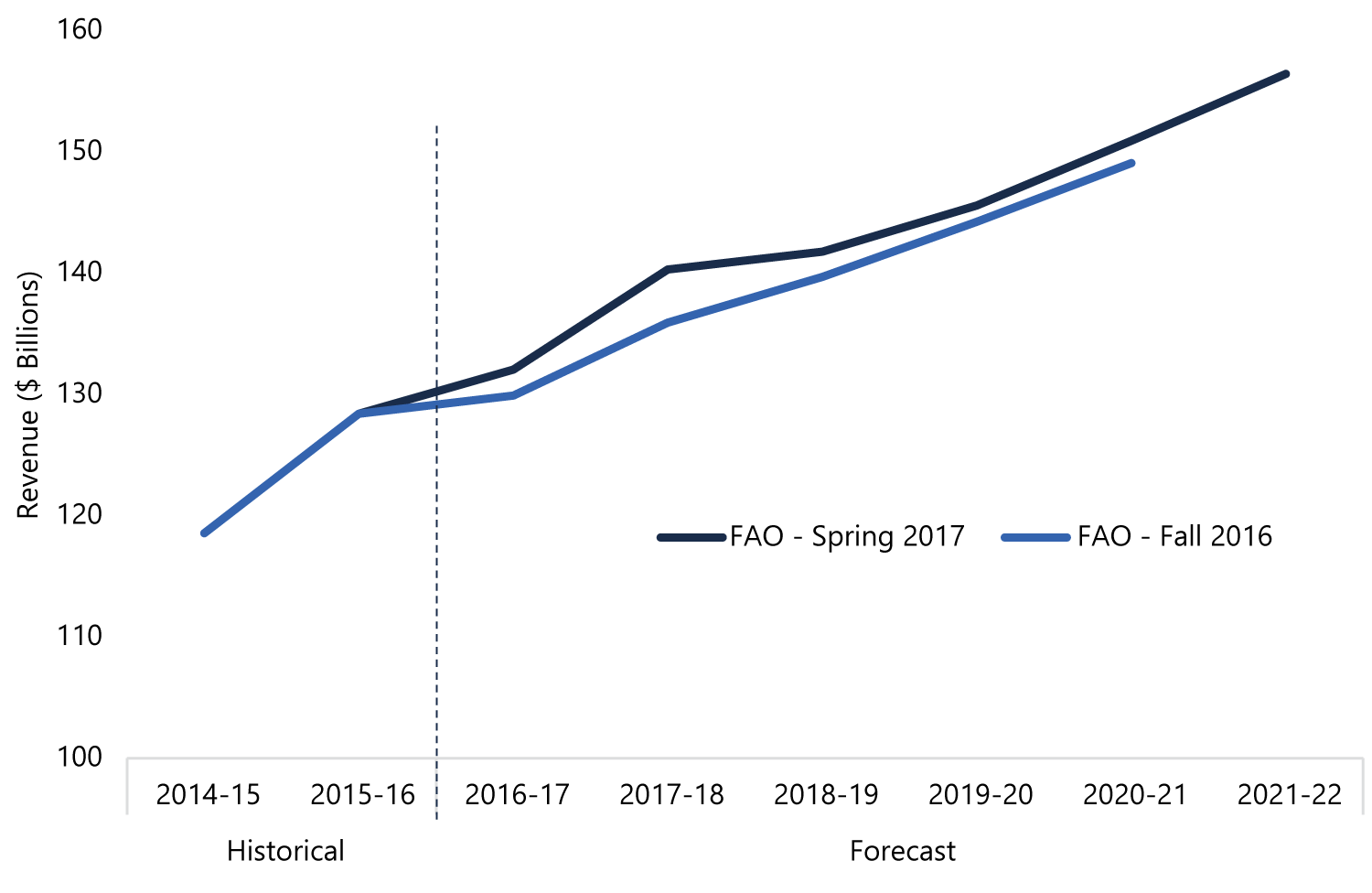
Source: FAO and Public Accounts.
FAO Revenue Assumptions and Forecast
|
Revenue Source |
Assumption |
Forecast |
|---|---|---|
|
Taxation Revenue |
Grows with key economic drivers including labour income, corporate profits and household spending |
Averages 3.9 per cent growth per year from 2016-17 to 2021-22 |
|
Federal Transfers |
Based on legislated growth rates and economic performance |
Federal transfers are expected to grow by 1.9 per cent per year from 2016-17 to 2021-22 |
|
Government Business Enterprises (GBE) |
Based on government projections |
Income from GBEs are projected to rise moderately from $5.3 billion in 2016-17 to $6.5 billion in 2021-22 |
|
Other Revenue |
Based on government projections, and includes asset sales, and proceeds from cap and trade allowances |
These revenues are projected to increase from $8.5 billion in 2016-17 to $11.0 billion in 2017-18, before declining to $8.5 billion by 2021-22 |
Stronger Economic Growth Expected to Boost Tax Revenue
Consistent with the FAO’s economic forecast, the FAO is currently projecting tax revenues to rise at an average of 3.9 per cent from 2016-17 to 2021-22, much stronger than the 3.0 per cent forecast in the FAO’s fall outlook.
Since the FAO’s fall report, nominal GDP – the broadest measure of the tax base – was revised significantly higher in 2016, improving the forecast for 2017.[18] However, beyond 2017, the outlook for nominal GDP growth is relatively unchanged from the fall forecast.
Nominal GDP up Significantly in the Near-Term Since the Fall
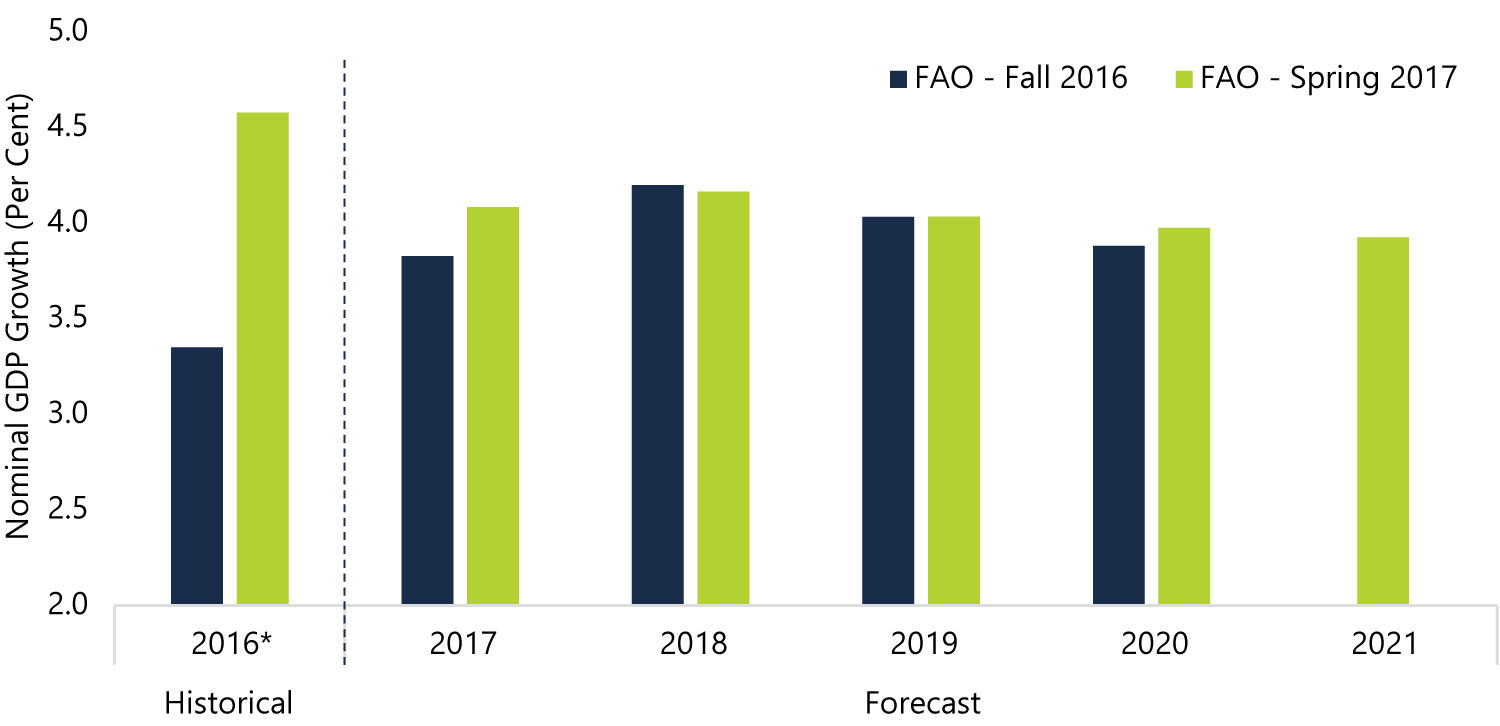
* 2016 value for the Fall 2016 EFO was the FAO’s forecast at the time of the report’s release.
Source: Ontario Economic Accounts and FAO.
Improved economic prospects are expected to lift the Province’s tax revenue by approximately $2.8 billion in 2016-17 and $4.2 billion in 2017-18, compared to the FAO’s fall estimates.
- Personal income tax revenue is forecast to grow stronger than expected in the fall due to the stronger forecast for labour income.[19]
- Corporations tax revenue is projected to benefit from the stronger outlook for corporate profits.
- Sales tax and land transfer tax revenues are forecast to grow stronger than expected in the fall due to the on-going strength in Ontario’s housing market.
Equalization Entitlement Declines
Given Ontario’s recent economic strength relative to the rest of Canada, the Province’s Equalization entitlement declined $0.8 billion to $1.4 billion in 2017-18. The FAO is projecting a further drop to $0.6 billion in 2018-19. Beyond 2018-19, the FAO is projecting that Ontario will no longer be entitled to Equalization payments — a reflection of the continued relative strength of the Ontario economy.
2017-18 Revenue to Benefit from One-time Increases
Based on the 2017 Budget, Ontario’s 2017-18 revenues will benefit from a one-time $3.0 billion boost,[20] that includes:
- $1.5 billion in higher revenue from federal transfers for infrastructure;
- $1.0 billion in increased sales and rentals revenue, reflecting additional asset sales[21]; and
- $0.5 billion in additional cap and trade proceeds from March 2017, which will be recognized in 2017-18.[22]
2017-18 Temporary Revenue Boost

Source: Ontario Budgets, Ministry of Finance and FAO.
Expense Outlook
Program Expense to Increase Significantly over the Outlook
The FAO projects program spending growth of 3.3 per cent per year over the 2016-17 to 2021-22 period.[23]
Over the 2016-17 to 2019-20 period, the FAO adopts the government’s 2017 Budget projections for program spending[24], adjusted to reflect the Auditor General’s recommended accounting presentation.[25] The expense outlook includes significant new spending across all sectors, including a new children and youth Pharmacare program, higher operating funding for hospitals, 24,000 new child care spaces[26], and the government’s new ‘Fair Hydro Plan’. As a result, spending is now forecast to be significantly higher than projected in the FAO’s fall outlook.
Program Expense Higher than Projected in the Fall
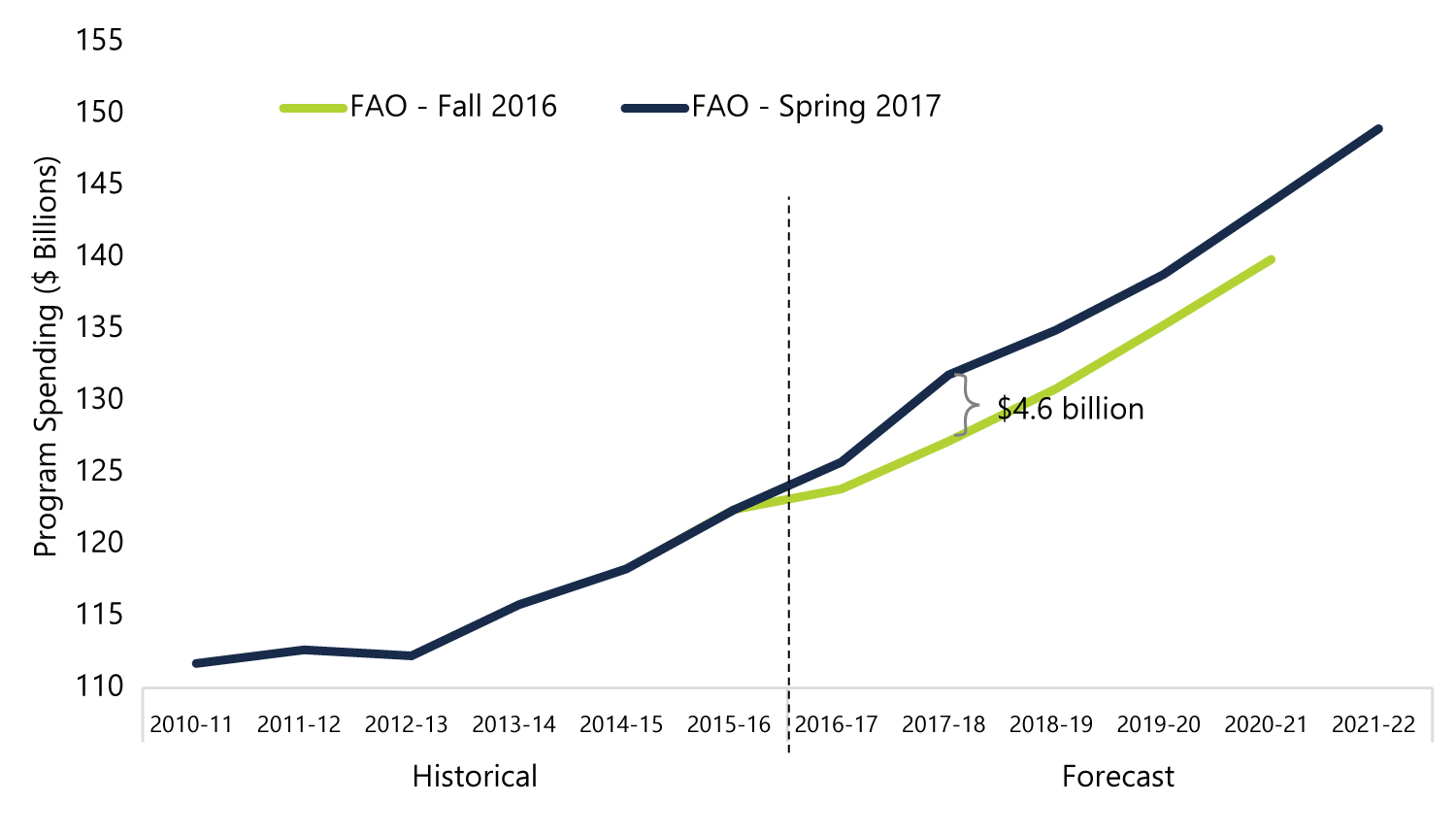
Note: Program spending includes the FAO’s estimate of the pension adjustment.
Source: Ontario Public Accounts, 2017 Ontario Budget and FAO.
With these new expenses, program spending is expected to grow 3.3 per cent per year on average over the next five years. This higher program spending growth is still slightly below the growth in underlying cost and demographic pressures, which is estimated to be 3.6 per cent on average.
Interest on Debt
The FAO projects interest on debt (IOD) payments will increase at an average annual rate of 4.0 per cent from $11.0 billion in 2015-16 to $13.9 billion by 2021-22, reflecting higher debt and rising interest rates over the outlook. This is faster than the average rate of program spending growth over the outlook.
Over the past five years, IOD as a share of revenue declined steadily, benefitting from falling interest rates. However, given the projected rise in interest rates over the outlook, the FAO forecasts that IOD as a share of revenue will increase from 8.1 per cent in 2017-18 to 8.9 per cent by 2021-22.
Interest on Debt to Rise Sharply as a Share of Revenues
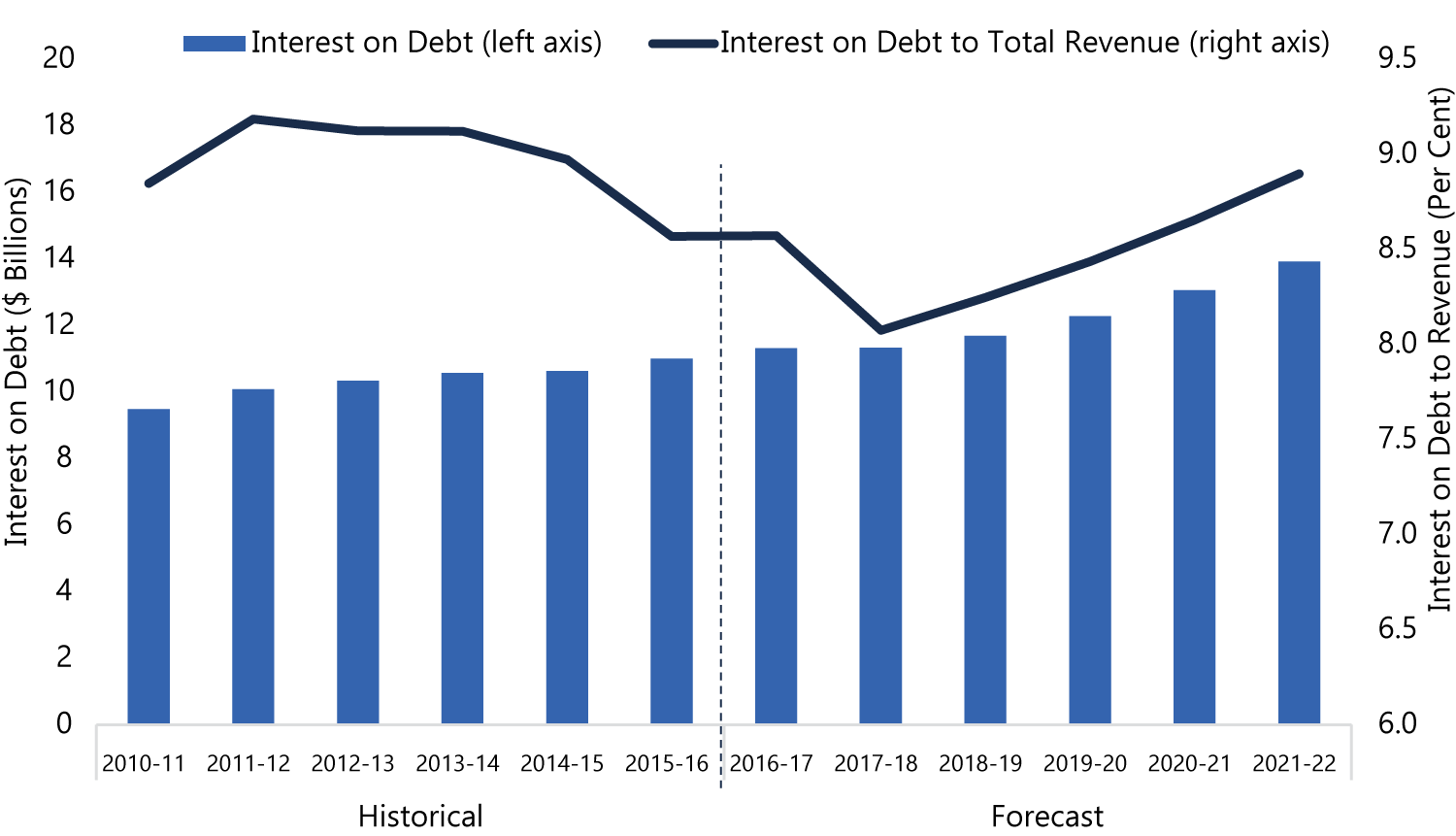
Source: Ontario Public Accounts and FAO.
Ontario Debt Outlook
Ontario Net Debt-to-GDP Ratio Will Remain Elevated
Ontario’s total borrowing requirements are expected to remain high over the outlook. To finance the cost of projected capital spending, on-going deficits and maturing debt issues the FAO estimates that provincial borrowing will average $37 billion per year over the next five years.
As a result, the FAO projects Ontario’s net debt to increase by $76 billion over the next five years to approximately $392 billion by 2021-22 based on the FAO’s application of the AG’s recommended accounting presentation. By comparison, using the government’s accounting presentation, the FAO projects Ontario’s net debt will rise by $62 billion to roughly $365 billion by 2021-22.
Based on the AG’s recommended accounting presentation, the FAO expects Ontario’s net debt-to-GDP ratio will edge higher to 40.3 per cent by 2021-22, reflecting the projected increase in net debt and the FAO’s forecast for nominal GDP growth. In contrast, based on the accounting presentation adopted by the government, the FAO projects that net debt-to-GDP will fall slightly from 38.6 per cent in 2015-16 to 37.5 per cent by 2021-22.
In the 2017 Budget, the Province set an interim net debt-to-GDP target of 35 per cent by 2023-24 and committed to lowering the ratio to 27 per cent by 2029-30. The FAO’s net debt-to-GDP projections under both accounting presentations, suggest that additional fiscal measures would be required for the government to achieve its interim target of 35 per cent by 2023-24.
Ontario’s Net Debt-to-GDP Ratio

Source: FAO, Ontario Economic Accounts, and 2017 Ontario Budget.
Note: AG recommended presentation is based on FAO estimates of the pension adjustment.
Risks to the Fiscal Plan and Policy Options
There are material risks that could impact Ontario’s fiscal position.
- A sharp correction in the housing market could present a significant risk for both the broader economy and for the Province’s fiscal plan. As discussed in an FAO commentary[27], a decline in house prices and housing market activity would directly reduce Land Transfer Tax and HST revenues. In addition, the broader economic impacts would lower personal and corporate income tax revenues.
- In the 2017 Budget, the government significantly reduced the prudence built into its program spending projection compared to the 2016 Budget, leaving less fiscal flexibility for the government to respond to unexpected events.[28] In addition, the FAO projects that interest on debt payments as a share of both program spending and revenue will increase significantly, exposing the government to added fiscal risk should interest rates rise faster than expected.
On the other hand, the government has increased spending growth to a rate closer to underlying spending pressures, diminishing the expense risk identified in earlier FAO reports.
Additionally, the government has a broad range of policy options that could improve its fiscal position, including the sale of additional public assets beyond announced targets. To date, the FAO estimates that the government has generated $6.4 billion in revenues from net asset sales, exceeding its target of $5.7 billion over 10 years. Given the government’s intention to sell Seaton and Lakeview lands[29], it would further overachieve its asset sales target.
Asset Optimization Revenues and Target
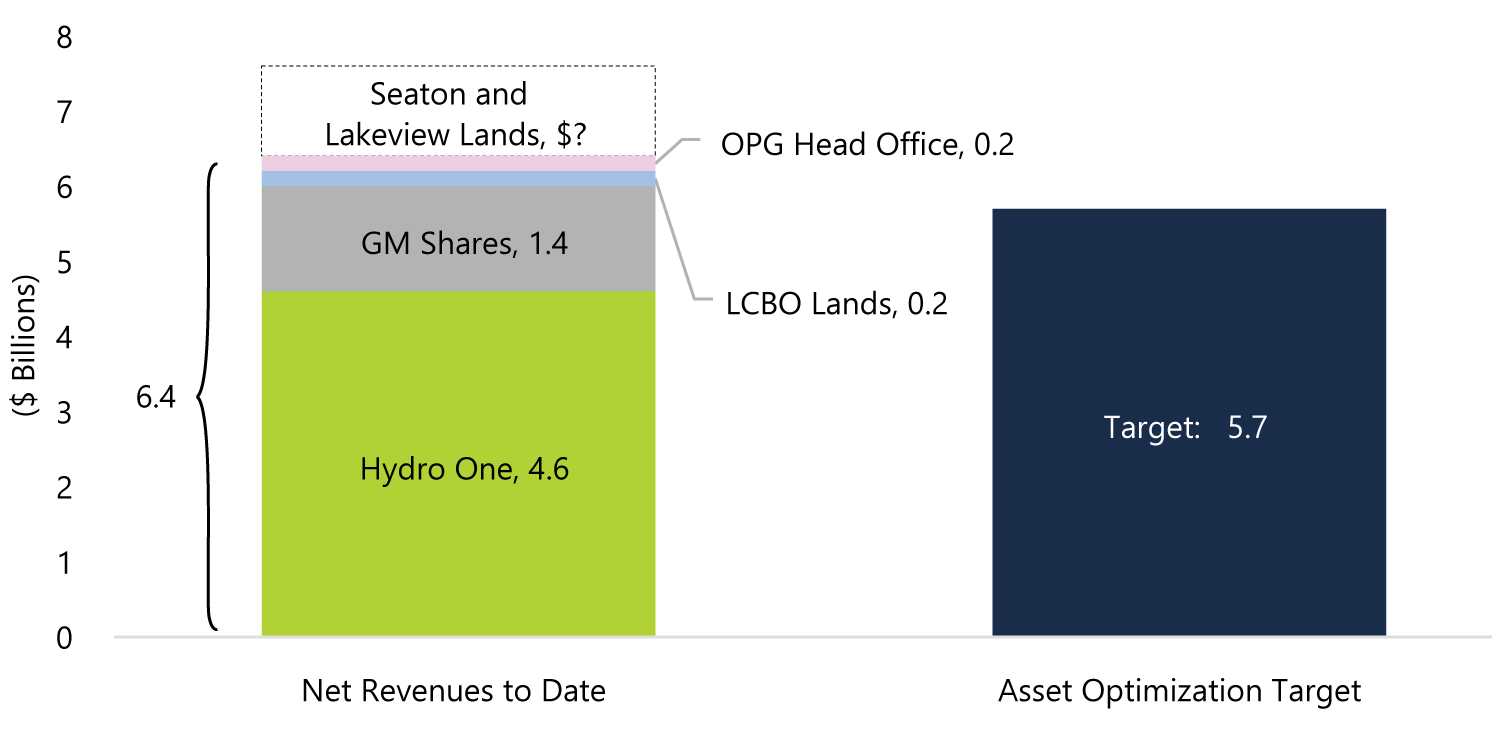
Source: FAO and Ontario Budgets.
Note: As of the 2017 Budget, the government had generated $3.8 billion in net proceeds from its sale of Hydro One equity. On May 8, 2017, the government announced the sale of an additional 22 per cent of Hydro One equity, which the FAO estimates will generate $0.8 billion in net proceeds.
The Accounting Treatment of Jointly Sponsored Pension Plans
Background
Ontario’s 2015-16 Public Accounts noted a disagreement between the Office of the Auditor General and the Province on the appropriate accounting treatment for net pension assets of jointly sponsored pension plans. Specifically, the Province is a joint sponsor of two pension plans, the Ontario Teachers’ Pension Plan (OTPP) and the Ontario Public Service Employees Union Pension Plan (OPSEUPP).
The government’s position is that these pension assets have been appropriately and consistently reflected on the Province’s financial statements since 2001. The Office of the Auditor General, based on a review of these pension assets, determined that a change in the accounting treatment was required. The Auditor General concluded that under current Canadian public sector accounting standards, the government could not unilaterally recognize a pension asset on its financial statements without evidence - in the form of a written agreement - permitting it to realize the asset through reduced contributions.[30]
In response, the Province adopted regulated accounting for 2015-16 to reflect the fiscal results according to the Auditor General’s interpretation of public sector accounting standards, and subsequently appointed a panel, the ‘Pension Asset Expert Advisory Panel’ to review and provide their recommended interpretation. The panel’s report[31], released in February 2017, concluded that the Province’s share of net assets in jointly sponsored pension plans should be fully recognized in the Province’s financial statements — contrary to the opinion of the Office of the Auditor General.
In the 2017 Budget, the government adopted the advisory panel’s interpretation of public sector accounting standards and recognized the net pension assets of the jointly sponsored pension plans. The 2017 Budget also indicated that the Province’s 2016–17 Public Accounts will report the net pension assets for the two jointly sponsored pension plans.
The Central Issue
The government and the Auditor General have put forward different interpretations of the application of public sector accounting standards for jointly sponsored pension plans.
The different interpretations centre on the question of whether the government has unilateral control of pension surplus assets in jointly sponsored pension plans. In particular, the issue is focused on whether an explicit written agreement between the co-sponsors (the government and the unions representing the employees) to lower future contributions is required for the government to recognize the value of the pension surplus assets.
According to the Auditor General, the issue can be resolved if the government presents an agreement with the Ontario Teacher’s Federation (OTF) allowing the government to access the OTPP pension assets through reduced contributions. The extent and duration of the reduced contributions would determine the size of the pension asset that the government could recognize in its financial statements.
The government’s position, based on the advice of the advisory panel, is that the existing agreements governing the pension plans, and past history, reflect the sponsors’ rights and intent to benefit from surplus assets in the plans through mechanisms reflected in the agreements to potentially realize a benefit through lower future contribution rates.
In the absence of an agreement, and given the government’s decision to accept the advisory panel’s recommended approach to accounting for jointly sponsored pension plan assets, the Auditor General would be expected to provide a qualified opinion[32] on Ontario’s 2016-17 Public Accounts.
Roles and Responsibilities of the Province and the Auditor General
The Province (through the Treasury Board Secretariat) is responsible for the preparation of Ontario’s Public Accounts in accordance with legislation, and based on the standards set out by the Public Sector Accounting Board (PSAB).[33] The PSAB accounting standards serve the public interest by providing an independent, high-quality accounting framework for public sector entities. The government is responsible to ensure that the financial reports fairly reflect the activities and financial position of the Province.
The Auditor General reviews the Province’s annual Public Accounts and provides an audit opinion to the Legislature on whether the Consolidated Financial Statements for the Province of Ontario present fairly, in all material respects, the Province’s financial position, in accordance with the PSAB accounting standards.
The FAO’s Presentation of Ontario’s Fiscal Outlook
The Financial Accountability Officer supports the Legislative Assembly by providing independent economic and financial analysis intended to improve the transparency of the government’s fiscal plan. The Officer looks to the Auditor General as the provincial authority on the appropriate interpretation and application of accounting standards for the Province.
The FAO has presented two fiscal projections, including and excluding the impact of the net pension assets of jointly sponsored pension plans, to help members of the Legislative Assembly better understand the implications of these different accounting interpretations on the Province’s fiscal position.
- The FAO projection based on the Auditor General’s recommended accounting presentation assumes a valuation allowance that offsets the net pension assets.
- The FAO projection based on the government’s accounting presentation recognizes the net pension assets.
In the absence of an agreement between the pension plan co-sponsors, this presentation of Ontario’s fiscal position would be expected to receive a qualified opinion from the Auditor General when published in the Province’s future Public Accounts.
Based on the Auditor General’s recommended accounting presentation for the net assets of jointly sponsored pension plans, and the FAO’s estimate of the pension adjustment, the FAO is projecting budget deficits of $2.9 billion in 2017-18, rising to $6.5 billion by 2021-22. Alternatively, based on the pension accounting presentation adopted by the government, the FAO is projecting budget deficits of $0.5 billion in 2017-18 rising to $3.6 billion in 2021-22.
Developments since the FAO’s Fall 2016 Economic and Fiscal Outlook
The FAO’s current projection of the Ontario budget balance has generally deteriorated relative to the FAO’s fall 2016 projection.
- Stronger than expected economic performance is expected to boost taxation revenues over the forecast, partially offset by lower Equalization revenue.
- Based on new government spending plans, program expense has increased significantly.
Developments since 2016 Fall EFO (AG Recommended Presentation)
|
2016-17 |
2017-18 |
2018-19 |
2019-20 |
2020-21 |
|
|---|---|---|---|---|---|
|
FAO’s Fall 2016 Budget Balance Forecast |
-5.2 |
-2.6 |
-2.8 |
-3.3 |
-3.7 |
|
|
|
|
|
|
|
|
Developments Since Fall 2016 |
|
|
|
|
|
|
Revenue |
|||||
|
Stronger Economic Outlook |
2.3 |
4.1 |
3.9 |
4.4 |
4.7 |
|
Lower Federal Transfers1 |
-0.3 |
0.2 |
-1.3 |
-2.4 |
-2.2 |
|
Other Revenue Changes2 |
0.1 |
0.1 |
-0.5 |
-0.6 |
-0.6 |
|
Total |
2.1 |
4.4 |
2.1 |
1.3 |
1.8 |
|
|
|||||
|
Expense |
|
|
|
|
|
|
Higher Spending, including Children and Youth Pharmacare, and Fair Hydro Plan |
1.2 |
3.8 |
3.0 |
2.2 |
2.7 |
|
Revised Adjustment for Pension Asset3 |
0.7 |
0.8 |
1.1 |
1.4 |
1.4 |
|
Total |
2.0 |
4.6 |
4.1 |
3.6 |
4.1 |
|
Total Developments |
0.2 |
-0.3 |
-2.1 |
-2.3 |
-2.3 |
|
|
|||||
|
FAO’s 2017 Spring Budget Balance Forecast |
-5.0 |
-2.9 |
-4.9 |
-5.5 |
-6.0 |
Notes:
1. Change in federal transfers forecast mainly due the reduction in Ontario’s Equalization payment.
2. Other revenue changes include the $0.5 billion re-profiling of cap-and-trade proceeds from 2016-17 to 2017-18, and an increase in sales and rentals for 2017-18.
3. In the 2016 Fall EFO, the FAO assumed an annual adjustment of $1.5 billion for the net pension assets of jointly sponsored pension plans. The current projection incorporates the FAO’s updated estimates for the pension adjustment of $2.2 billion in 2016-17, increasing to $2.9 billion by 2020-21.
Source: FAO.
Forecast Tables
Table 1a: FAO Outlook for Key Revenue Drivers*
|
(Per Cent Growth) |
2015a |
2016a |
2017f |
2018f |
2019f |
2020f |
2021f |
Average** |
|---|---|---|---|---|---|---|---|---|
|
Nominal GDP |
|
|||||||
|
FAO – Spring 2017 |
4.9 |
4.6 |
4.1 |
4.2 |
4.0 |
4.0 |
3.9 |
4.1 |
|
2017 Ontario Budget |
4.9 |
4.6 |
4.3 |
4.1 |
4.2 |
3.9 |
- |
4.1 |
|
Current FAO Consensus *** |
- |
- |
3.9 |
4.3 |
4.1 |
3.8 |
4.0 |
4.0 |
|
Labour Income |
||||||||
|
FAO – Spring 2017 |
4.2 |
4.2 |
4.0 |
4.1 |
4.1 |
3.9 |
3.8 |
4.0 |
|
2017 Ontario Budget **** |
- |
4.4 |
4.1 |
4.5 |
4.6 |
4.2 |
- |
4.3 |
|
Corporate Profits |
||||||||
|
FAO – Spring 2017 |
9.1 |
9.2 |
6.0 |
6.3 |
5.5 |
4.7 |
4.5 |
5.6 |
|
2017 Ontario Budget |
- |
9.2 |
6.8 |
7.1 |
5.4 |
4.0 |
- |
5.8 |
|
Nominal Household Spending |
||||||||
|
FAO – Spring 2017 |
3.9 |
4.2 |
4.2 |
3.7 |
3.4 |
3.5 |
3.6 |
3.8 |
|
2017 Ontario Budget |
- |
4.2 |
4.3 |
4.2 |
4.2 |
- |
- |
4.2 |
a = Actual f = Forecast
* “Labour income”, “corporate profits” and “household spending” are defined by Statistics Canada as “compensation of employees”, “net operating surplus: corporations”, and “household consumption” respectively.
** For comparison purposes, average is calculated from 2017 to 2020 and 2017 to 2019 for Household Spending.
*** FAO consensus includes forecasts from the Centre for Spatial Economics, the Conference Board of Canada and the Policy and Economic Analysis Program at the University of Toronto.
**** 2017 Ontario Budget reports Labour Income on a National Basis, whereas FAO reports Labour Income on a Domestic Basis.
Source: 2017 Ontario Budget, Statistics Canada, Ontario Economic Accounts, FAO Consensus and FAO.
Table 1b: FAO Outlook for Ontario Real GDP and Components
|
(Per Cent Growth) |
2015a |
2016a |
2017f |
2018f |
2019f |
2020f |
2021f |
Average* |
|---|---|---|---|---|---|---|---|---|
|
Real GDP |
||||||||
|
FAO – Spring 2017 |
2.5 |
2.7 |
2.4 |
2.1 |
2.0 |
2.0 |
1.9 |
2.1 |
|
2017 Ontario Budget |
2.5 |
2.7 |
2.3 |
2.1 |
2.0 |
1.7 |
- |
2.0 |
|
Current FAO Consensus ** |
- |
- |
2.1 |
2.3 |
2.1 |
1.9 |
1.9 |
2.1 |
|
Real GDP Components |
||||||||
|
Household Spending *** |
2.7 |
2.7 |
2.3 |
1.9 |
1.9 |
1.8 |
1.8 |
2.0 |
|
Residential Investment |
7.2 |
7.9 |
3.5 |
-1.3 |
-2.0 |
1.9 |
2.4 |
0.5 |
|
Business Investment **** |
8.2 |
-4.0 |
0.2 |
5.6 |
5.7 |
4.9 |
3.9 |
4.1 |
|
Government (Consumption and Investment) |
1.9 |
1.6 |
1.7 |
1.3 |
1.2 |
1.1 |
1.0 |
1.3 |
|
Exports |
2.8 |
3.0 |
2.4 |
2.7 |
2.5 |
2.3 |
2.2 |
2.5 |
|
Imports |
3.7 |
1.4 |
2.2 |
2.2 |
2.3 |
2.2 |
2.1 |
2.2 |
a = Actual f = Forecast
* For comparison purposes, average is calculated from 2017 to 2020
** FAO consensus includes forecasts from the Centre for Spatial Economics, the Conference Board of Canada and the Policy and Economic Analysis Program at the University of Toronto.
*** Household Spending is Household and Non-Profit Consumption Expenditure.
**** Business Investment is Non-residential Investment and Machinery & Equipment.
Source: 2017 Ontario Budget, Statistics Canada, Ontario Economic Accounts, FAO Consensus and FAO.
Table 2: FAO Outlook for Selected Economic Indicators
|
2015a |
2016a |
2017f |
2018f |
2019f |
2020f |
2021f |
|
|---|---|---|---|---|---|---|---|
|
Employment (Per Cent Growth) |
|||||||
|
FAO – Spring 2017 |
0.7 |
1.1 |
1.3 |
1.1 |
1.0 |
0.9 |
0.9 |
|
2017 Ontario Budget |
0.7 |
1.1 |
1.3 |
1.2 |
1.1 |
0.9 |
- |
|
Unemployment Rate (Per Cent) |
|||||||
|
FAO – Spring 2017 |
6.8 |
6.5 |
6.4 |
6.3 |
6.3 |
6.3 |
6.2 |
|
2017 Ontario Budget |
6.8 |
6.5 |
6.4 |
6.3 |
6.2 |
6.2 |
- |
|
Labour Force (Per Cent Growth) |
|||||||
|
FAO – Spring 2017 |
0.1 |
0.9 |
1.1 |
1.0 |
1.0 |
0.9 |
0.9 |
|
2017 Ontario Budget |
- |
- |
- |
- |
- |
- |
- |
|
Population Growth (Per Cent) |
|||||||
|
FAO – Spring 2017 |
0.8 |
1.3 |
1.3 |
1.1 |
1.1 |
1.1 |
1.1 |
|
2017 Ontario Budget |
- |
- |
- |
- |
- |
- |
- |
|
CPI Inflation (Per Cent Growth) |
|||||||
|
FAO – Spring 2017 |
1.2 |
1.8 |
2.1 |
2.1 |
2.0 |
2.0 |
2.0 |
|
2017 Ontario Budget |
1.2 |
1.8 |
2.0 |
2.0 |
2.0 |
2.0 |
- |
|
Canada Real GDP (Per Cent Growth) |
|||||||
|
FAO – Spring 2017 |
0.9 |
1.4 |
2.2 |
2.3 |
2.0 |
1.9 |
1.9 |
|
2017 Ontario Budget |
0.9 |
1.4 |
2.1 |
2.0 |
1.9 |
1.7 |
- |
|
U.S. Real GDP (Per Cent Growth) |
|||||||
|
FAO – Spring 2017 |
2.6 |
1.6 |
2.3 |
2.3 |
2.2 |
2.1 |
2.1 |
|
2017 Ontario Budget |
2.6 |
1.6 |
2.3 |
2.4 |
2.1 |
2.0 |
- |
|
Canadian Dollar (Cents US) |
|||||||
|
FAO – Spring 2017 |
78.2 |
75.4 |
75.6 |
78.4 |
78.8 |
79.9 |
81.3 |
|
2017 Ontario Budget |
78.2 |
75.4 |
74.5 |
75.5 |
78.5 |
80.0 |
- |
|
WTI Crude Oil (US$) |
|||||||
|
FAO – Spring 2017 |
49 |
43 |
54 |
55 |
56 |
61 |
68 |
|
2017 Ontario Budget |
49 |
43 |
54 |
59 |
62 |
64 |
- |
|
Three-month Treasury Bill Rate (Per Cent) |
|||||||
|
FAO – Spring 2017 |
0.5 |
0.5 |
0.6 |
1.4 |
1.9 |
2.3 |
2.6 |
|
2017 Ontario Budget |
0.5 |
0.5 |
0.5 |
0.8 |
1.5 |
1.9 |
- |
|
10-year Government Bond Rate (Per Cent) |
|||||||
|
FAO – Spring 2017 |
1.5 |
1.3 |
1.8 |
2.5 |
2.9 |
3.6 |
3.9 |
|
2017 Ontario Budget |
1.5 |
1.3 |
1.9 |
2.4 |
3.0 |
3.2 |
- |
a = Actual f = Forecast
Source: 2017 Ontario Budget, Bank of Canada, Congressional Budget Office, Statistics Canada, FAO Consensus and FAO.
Table 3: FAO Fiscal Outlook
|
($ Billions) |
2015-16a |
2016-17f |
2017-18f |
2018-19f |
2019-20f |
2020-21f |
2021-22f |
|---|---|---|---|---|---|---|---|
|
Revenue |
|||||||
|
Personal Income Tax |
31.1 |
32.4 |
34.5 |
36.7 |
38.6 |
40.5 |
42.5 |
|
Sales Tax |
23.5 |
24.7 |
25.8 |
26.5 |
27.3 |
28.2 |
29.2 |
|
Corporations Tax |
11.4 |
12.7 |
13.3 |
14.0 |
14.6 |
15.1 |
15.6 |
|
All Other Taxes |
25.8 |
24.0 |
25.1 |
25.9 |
26.9 |
27.6 |
28.5 |
|
Total Taxation Revenue |
91.8 |
93.9 |
98.7 |
103.1 |
107.3 |
111.5 |
115.8 |
|
Transfers from Government of Canada |
22.9 |
24.3 |
25.7 |
24.6 |
24.1 |
24.8 |
25.6 |
|
Income from Government Business Enterprise |
4.9 |
5.3 |
4.9 |
5.7 |
6.0 |
6.3 |
6.5 |
|
Other Non-Tax Revenue |
8.8 |
8.5 |
11.0 |
8.3 |
8.1 |
8.3 |
8.5 |
|
Total Revenue |
128.4 |
132.0 |
140.3 |
141.8 |
145.6 |
150.9 |
156.4 |
|
Expense |
|||||||
|
Health Sector |
51.0 |
52.2 |
53.8 |
56.3 |
58.1 |
60.6 |
63.3 |
|
Education Sector |
25.0 |
25.7 |
26.5 |
27.4 |
28.0 |
29.0 |
29.8 |
|
Postsecondary and Training Sector |
7.7 |
7.8 |
8.4 |
8.3 |
8.4 |
8.5 |
8.6 |
|
Children's and Social Services Sector |
15.6 |
16.2 |
16.9 |
17.2 |
17.4 |
18.0 |
18.5 |
|
Justice Sector |
4.5 |
4.6 |
4.7 |
4.7 |
4.8 |
4.9 |
5.0 |
|
Other Programs* |
18.6 |
19.2 |
21.5 |
21.0 |
22.1 |
22.9 |
23.7 |
|
Total Program Expense* |
122.4 |
125.7 |
131.8 |
134.9 |
138.8 |
143.8 |
149.0 |
|
Interest on Debt |
11.0 |
11.3 |
11.3 |
11.7 |
12.3 |
13.1 |
13.9 |
|
Total Expense* |
133.4 |
137.0 |
143.1 |
146.6 |
151.1 |
156.9 |
162.9 |
|
Budget Balance* (AG Presentation) |
-5.0 |
-5.0 |
-2.9 |
-4.9 |
-5.5 |
-6.0 |
-6.5 |
|
Adjustment for Pension Assets |
-1.5 |
-2.2 |
-2.3 |
-2.6 |
-2.9 |
-2.9 |
-2.9 |
|
Budget Balance |
-3.5 |
-2.8 |
-0.5 |
-2.2 |
-2.6 |
-3.1 |
-3.6 |
|
Budget Balance (2017 Ontario Budget) |
-3.5 |
-1.5 |
0.6 |
0.6 |
0.9 |
- |
- |
a = Actual f = Forecast
* Based on the FAO’s application of the Auditor General’s recommended accounting for these pension assets
Note: Budget balance is presented without reserve.
Source: 2017 Ontario Budget and FAO.
Table 4a: FAO Debt Outlook (Auditor General Recommended Presentation)
|
$ Billions |
2015-16a |
2016-17f |
2017-18f |
2018-19f |
2019-20f |
2020-21f |
2021-22f |
|---|---|---|---|---|---|---|---|
|
Budget Balance* |
-5.0 |
-5.0 |
-2.9 |
-4.9 |
-5.5 |
-6.0 |
-6.5 |
|
Accumulated Deficit |
202.7 |
207.7 |
210.6 |
215.5 |
221.0 |
227.0 |
233.5 |
|
Net Debt |
305.2 |
316.1 |
329.5 |
346.4 |
365.4 |
379.4 |
391.7 |
|
Change in Net Debt |
10.9 |
13.5 |
16.8 |
19.0 |
14.0 |
12.3 |
|
|
Net Debt to GDP (Per Cent) |
40.0 |
39.6 |
39.7 |
40.0 |
40.6 |
40.5 |
40.3 |
a = Actual f = Forecast
* Budget Balance is presented without reserve. Includes the FAO’s estimate of the pension adjustment.
Source: Statistics Canada, 2017 Ontario Budget and FAO.
Table 4b: FAO Debt Outlook (Government Presentation)
|
$ Billions |
2015-16a |
2016-17f |
2017-18f |
2018-19f |
2019-20f |
2020-21f |
2021-22f |
|---|---|---|---|---|---|---|---|
|
Budget Balance* |
-3.5 |
-2.8 |
-0.5 |
-2.2 |
-2.6 |
-3.1 |
-3.6 |
|
Accumulated Deficit |
192.0 |
194.8 |
195.3 |
197.6 |
200.2 |
203.3 |
206.9 |
|
Net Debt |
294.6 |
303.1 |
314.3 |
328.5 |
344.6 |
355.7 |
365.1 |
|
Change in Net Debt |
8.7 |
11.2 |
14.2 |
16.1 |
11.1 |
9.4 |
|
|
Net Debt to GDP (Per Cent) |
38.6 |
38.0 |
37.8 |
38.0 |
38.3 |
38.0 |
37.5 |
|
Net Debt to GDP from 2017 Budget (Per Cent) |
38.6 |
37.8 |
37.5 |
37.3 |
37.2 |
36.9 |
36.3 |
a = Actual f = Forecast
* Budget Balance is presented without reserve.
Source: Statistics Canada, 2017 Ontario Budget and FAO.
Provincial Comparisons
|
|
NL |
PE |
NS |
NB |
QC |
Ontario* |
MB |
SK |
AB |
BC |
|---|---|---|---|---|---|---|---|---|---|---|
|
Fiscal Performance (2015-16) |
||||||||||
|
Total Revenue |
||||||||||
|
Per Capita ($) |
11,149 |
11,276 |
10,119 |
11,118 |
12,037 |
9,305 |
11,616 |
12,041 |
10,168 |
10,144 |
|
to GDP (%) |
19.6 |
26.7 |
23.7 |
25.4 |
26.1 |
16.8 |
22.9 |
17.2 |
13.0 |
19.0 |
|
Total Program Expenditures |
||||||||||
|
Per Capita ($) |
13,763 |
10,592 |
9,632 |
10,564 |
10,610 |
8,874 |
11,609 |
12,938 |
11,524 |
9,395 |
|
to GDP (%) |
24.2 |
25.1 |
22.6 |
24.1 |
23.0 |
16.0 |
22.8 |
18.4 |
14.8 |
17.6 |
|
Interest on Debt |
||||||||||
|
Per Capita ($) |
1,547 |
872 |
906 |
899 |
1,217 |
795 |
660 |
445 |
186 |
594 |
|
to GDP (%) |
2.7 |
2.1 |
2.1 |
2.1 |
2.6 |
1.4 |
1.3 |
0.6 |
0.2 |
1.1 |
|
to Revenue (%) |
13.9 |
7.7 |
9.0 |
8.1 |
10.1 |
8.5 |
5.7 |
3.7 |
1.8 |
5.9 |
|
Total Expenditures |
||||||||||
|
Per Capita ($) |
15,310 |
11,465 |
10,538 |
11,463 |
11,828 |
9,669 |
12,269 |
13,383 |
11,710 |
9,989 |
|
to GDP (%) |
26.9 |
27.2 |
24.7 |
26.2 |
25.6 |
17.5 |
24.1 |
19.1 |
15.0 |
18.8 |
|
Primary Balance |
||||||||||
|
Per Capita ($) |
-2,613 |
684 |
487 |
554 |
1,427 |
430 |
7 |
-897 |
-1,356 |
749 |
|
to GDP (%) |
-8.7 |
11.0 |
1.2 |
1.7 |
0.4 |
0.1 |
0.0 |
-1.1 |
-0.4 |
0.3 |
|
Deficit (-) or surplus |
||||||||||
|
Level (Millions $) |
-2,200 |
-28 |
-11 |
-261 |
1,431 |
-5,029 |
-846 |
-1,520 |
-6,442 |
730 |
|
Per Capita ($) |
-4,160 |
-189 |
-11 |
-345 |
173 |
-364 |
-653 |
-1,342 |
-1,541 |
156 |
|
to GDP (%) |
-7.3 |
-0.4 |
0.0 |
-0.8 |
0.4 |
-0.7 |
-1.3 |
-1.9 |
-2.0 |
0.3 |
|
Net Debt |
||||||||||
|
Level (Millions $) |
12,633 |
2,183 |
15,097 |
13,660 |
187,098 |
305,233 |
21,433 |
7,899 |
-3,881 |
39,635 |
|
Per Capita ($) |
23,896 |
14,880 |
16,003 |
18,109 |
22,653 |
22,123 |
16,538 |
6,977 |
-929 |
8,446 |
|
to GDP (%) |
42.0 |
35.3 |
37.5 |
41.3 |
49.1 |
40.0 |
32.5 |
9.9 |
-1.2 |
15.9 |
|
Economic and Demographic Indicator Growth (2015) (Per Cent) |
||||||||||
|
Real GDP |
-2.0 |
1.3 |
1.0 |
2.3 |
1.2 |
2.5 |
2.2 |
-1.3 |
-3.6 |
3.3 |
|
Nominal GDP |
-11.5 |
3.9 |
2.4 |
2.9 |
2.6 |
4.9 |
3.1 |
-5.7 |
-12.5 |
3.8 |
|
Employment |
-1.0 |
-1.1 |
0.1 |
-0.6 |
0.9 |
0.7 |
1.5 |
0.5 |
1.2 |
1.2 |
|
Population |
0.1 |
0.6 |
0.0 |
-0.1 |
0.5 |
0.8 |
1.2 |
1.0 |
1.7 |
1.0 |
* Ontario 2015-16 Fiscal Performance measures are presented after adjustment for pension assets.
Source: FAO, Department of Finance Canada’s Fiscal Reference Tables (September, 2016) and Statistics Canada.
5. About this document
Established by the Financial Accountability Officer Act, 2013, the Financial Accountability Office (FAO) provides independent analysis on the state of the Province’s finances, trends in the provincial economy and related matters important to the Legislative Assembly of Ontario. The FAO’s Economic and Fiscal Outlook is released each spring and fall, providing an assessment of the province’s medium-term economic performance and fiscal position.
This report was prepared by Edward Crummey, Luan Ngo, Nicolas Rhodes and Mario Angastiniotis under the direction of David West. External reviewers were provided with earlier drafts of this report for their comments. However, the input of external reviewers implies no responsibility for this final report, which rests solely with the FAO.
This report is based on information available to May 2, 2017. Background data used in this report are available upon request.
FAO’s Fiscal Projections
The FAO forecasts provincial finances based on projections of existing and announced revenue and spending policies. The forecast represents the FAO’s view of the most likely fiscal outcomes given existing policies, without anticipating any new government policy decisions. The FAO’s tax revenue projections are based on an assessment of the outlook for the provincial economy and current tax policies. Given the government’s discretion over spending, the FAO adopts the government’s announced spending plans from fiscal documents and incorporates policy announcements as appropriate. Beyond the government’s published spending projections, the FAO forecasts spending based on the outlook for underlying cost drivers including demographics and price inflation.
[1] See the discussion "The Accounting Treatment of Jointly Sponsored Pension Plans"of the Fiscal Outlook chapter for background and context.
[2] “World Economic Outlook, Gaining Momentum?”, April 2017, International Monetary Fund.
[3] “World Economic Outlook, October 2016: Subdued Demand: Symptoms and Remedies”, October 2016, International Monetary Fund.
[4] The FAO forecast for the U.S. economy in 2017 is based on the U.S. Congressional Budget Office’s (CBO) latest forecast. For 2018 to 2021, the U.S. forecast is based on the average of the CBO outlook and the forecasts of three independent model-based forecasters – the Conference Board of Canada, the Centre for Spatial Economics and the Policy and Economic Analysis Program at the University of Toronto.
[5] These forecasters include the IMF, CBO, TD Bank, RBC, BMO Capital Markets and National Bank Economics.
[6] The FAO forecast for the Canadian economy is based on the average quarterly forecasts of two independent, model-based forecasters – the Conference Board of Canada and the Policy and Economic Analysis Program at the University of Toronto.
[7] The Federal Reserve raised its key policy rate, or the Federal Funds Rate, to 1.0 per cent on March 15, 2017.
[8] In its most recent monetary policy report, the Bank of Canada (BOC) indicated that it expects the output gap to close in early 2018. At the same time, the BOC noted that “there is still considerable uncertainty about the outlook,” suggesting caution with regard to future changes in its policy interest rate. Bank of Canada Monetary Policy Report, April, 2017.
[9] Ontario Economic Accounts, Fourth Quarter 2016, released April 13, 2017.
[10] As noted in a recent Conference Board of Canada report, nearly half of Ontario businesses are operating near or above capacity, hampering the ability of Ontario businesses to increase production to meet foreign demand. Conference Board of Canada Outlook, Winter 2017.
[11] Net exports are exports less imports of goods and services.
[12] The FAO forecast of the Ontario economy is based on the FAO’s short-term quarterly model of the Ontario economy. For a description of the model, please refer to the textbox at the end of the Economic Outlook chapter.
[13] For a more detailed discussion on Ontario’s labour market, see the FAO’s Commentary: “Ontario Posts Solid 2016 Job Gain as the Labour Market Continues to Evolve”.
[14] The robust 2016 increase in nominal GDP was much stronger than the 3.4 per cent increase projected in both the FAO’s Economic and Fiscal Outlook, Fall 2016 Update and the government’s 2016 Economic Outlook and Fiscal Review. The sharp upward shift in 2016 nominal GDP growth reflects large historical revisions to 2015 and 2016 nominal GDP growth in the Ontario Economic Accounts, consistent with new data from Statistics Canada. In particular, the net operating surplus of corporations is now estimated to have increased by 9.2 per cent in 2016 compared to an original projection of 0.3 per cent last fall.
[15] Almost one-quarter (22 per cent) of the growth in nominal GDP in 2016 was directly attributable to the increase in residential investment spending.
[16] The FAO projection based on the Auditor General’s recommended accounting presentation assumes a valuation allowance that effectively writes off the value of any net pension assets – referred to as the ‘pension adjustment’ in this report. The valuation allowance increases ‘other program’ expense, resulting in higher deficits under the AG’s recommended accounting presentation.
[17] Under the government’s accounting presentation, Ontario’s public accounts would be expected to receive a qualified opinion from the Auditor General.
[18] See economic section, and footnote [14].
[19] However, near-term revenue growth will be somewhat dampened as some high-income earners shifted earnings into the 2015 tax year to avoid the new higher 33 per cent tax rate introduced by the federal government in 2016 (http://www.fin.gc.ca/afr-rfa/2016/report-rapport-eng.asp#_Toc463249478). Using Finance Canada estimates, the FAO estimates that roughly $600 million of Ontario’s 2015 PIT revenue was due to income shifting, which lowers taxable income in 2016-17 and 2017-18.
[20] This one-time benefit is incorporated into the FAO’s revenue projection.
[21] A portion of this increase reflects the Province’s sale of 22 per cent of Hydro One equity in 2017-18, compared to a 15 per cent sale in 2016-17. The FAO estimates that this sale would generate about $0.8 billion in revenue gains in 2017-18, compared to a gain of $0.5 billion in 2016-17.
[22] The government indicated that the cap and trade revenues from the March 2017 auction will be reported in fiscal year 2017-18, because the allowances were certified and delivered on April 2, 2017.
[23] The FAO’s projection extends to 2021-22, two years beyond the 2017 Ontario Budget forecast.
[24] Given the government’s discretion over spending, the FAO adopts the government’s announced spending plans and incorporates policy announcements as appropriate.
[25] The FAO’s estimates the pension adjustment will increase ‘other program’ expense by $2.2 billion in 2016-17, rising to $2.9 billion by 2021-22.
[26] The 2017 Budget announced 24,000 new child care spaces for 2017–18, as part of the government’s September 2016 Throne Speech commitment to create 100,000 new child care spaces by 2022.
[27] “The Impact of a Housing Market Correction on Ontario’s Fiscal Position”, Financial Accountability Office of Ontario, February 15, 2017.
[28] In the 2017 Budget, contingency funds total $0.6 billion for the coming fiscal year, half the size built into the 2016 Budget fiscal plan. Similarly, the government’s target for year-end savings has increased to $1.2 billion for the coming year, compared to $0.8 billion in Budget 2016.
[29] 2017 Ontario Budget, page 161.
[30] The Auditor General indicated that her office began reviewing the treatment of pension assets after these assets started to materially affect the government’s fiscal position (Auditor General's Statement on Pension Assets, February 16, 2017).
[31] https://news.ontario.ca/tbs/en/2017/02/pension-asset-expert-advisory-panel-submits-report.html.
[32] An auditor may provide a qualified opinion when financial statements do not conform in a material way to the applicable accounting standards.
[33] https://www.ontario.ca/page/public-accounts-101-guide#section-6].
Ontario’s Budget Balance
This chart shows Ontario’s budget balance before the reserve from 2015-16 to 2021-22 under three different bases: the FAO’s forecast based on the AG’s recommended accounting treatment for pension assets; the FAO’s forecast based on the government’s presentation; and the government’s forecast as presented in the 2017 Budget. The FAO’s forecast of the deficit based on the AG’s recommended presentation is $5.0 billion in 2016-17, $2.9 billion in 2017-18 and rising to $6.5 billion by 2021-22. The FAO’s forecast on the government’s basis, shows a budget deficit of $2.8 billion n 2016-17, $0.5 billion in 2017-18 and increasing to $3.6 billion by 2021-22. The government’s forecast shows a deficit of $1.5 billion in 2016-17, and a surplus of $0.6 billion in 2017-18 rising to a surplus of $0.9 billion by 2019-20.
Ontario’s Net Debt to GDP Ratio
This chart shows the historical and forecasted net debt-to-GDP ratio from 2010-11 to 2021-22 under three different bases: the FAO’s forecast based on the AG’s recommended presentation; the FAO’s forecast based on the government’s presentation; and the government’s forecast as presented in the 2017 Budget. The graph shows the FAO’s forecast of the ratio based on the AG’s accounting presentation rising over the outlook to 40.3 per cent by 2021-22, whereas the FAO’s forecast based on the government’s accounting presentation falls to 37.5 per cent by 2021-22. The government’s forecast as presented in the 2017 Budget, shows net debt-to-GDP declining to 36.3 per cent by 2021-22. The chart also shows historical and forecasted total net debt, based on both the AG’s and government’s accounting presentation. Net debt rises throughout the forecast, but is higher when the AG’s accounting presentation is used.
Solid Economic Performance Expected over Outlook
This chart compares the FAO’s forecast for nominal and real GDP with the government’s forecast as published in the 2017 Budget from 2016 to 2021. The forecasts for real GDP and nominal GDP growth over the outlook are, on average, in-line with the forecasts published in the 2017 Budget. The FAO’s forecast of real GDP grows by 2.4 per cent in 2017 and 2.1 per cent in 2018, slowing to 2.0 per cent in 2019 and 2020 and 1.9 per cent in 2021. The FAO’s forecast for nominal GDP grows by 4.1 per cent in 2017 and 4.2 per cent in 2018, slowing to 4.0 per cent in 2019 and 2020 and 3.9 per cent in 2021.
Global Growth to Improve in 2017
This chart shows the IMF’s historical and forecasted real GDP growth for three groups of countries: (1) world, (2) advanced economies, and (3) emerging market and developing economies. Growth rates for all three groups has been trending downwards from 2010 to 2016. The IMF is forecasting slightly stronger growth for all three groups in 2017. In 2018, growth for the world economy and emerging market and developing economies is expected to improve further, while growth for advanced economies is expected to remain unchanged at 2 per cent.
U.S. Economic Growth Moderates Beyond 2017
This chart shows the historical and forecasted U.S. real GDP growth rate from 2013 to 2021. U.S. growth is expected to improve to 2.3 per cent in 2017 from 1.6 per cent in 2016, continuing at 2.3 per cent in 2018, and averaging 2.1 per cent from 2019 to 2021.
Canada GDP Growth Expected to Improve in 2017
This chart shows the historical and forecasted Canada real GDP growth rate from 2013 to 2021. Real GDP is expected to rise by 2.2 per cent in 2017 and 2.3 per cent in 2018 and grow at an average rate of 2.0 per cent from 2018 to 2021.
Canadian Interest Rates to Rise Over the Forecast
This chart shows the historical and forecasted 3-month Treasury bill rate and the 10-year Government of Canada bond yield from 2007 to 2021. The 3-month Treasury bill rate is expected to rise modestly from 0.5 per cent in 2016 to 0.6 per cent by 2017 and continue to rise to 2.6 per cent by 2021. The 10-year Government of Canada bond yield is expected to rise from 1.3 per cent in 2016 to 3.9 per cent by 2021.
Exports and Business Investment Expected to Drive Economic Growth
This chart shows average growth rates over the periods 2015 to 2017 and 2018 to 2021 for three categories: (1) Ontario real GDP, (2) household spending and residential investment and (3) exports and business investment. Real GDP is expected to grow at a slower average annual rate of 2.0 per cent over 2018 to 2021 compared to 2.5 per cent over 2015 to 2017. Growth in household spending and residential investment is expected to drop from an average of 2.9 percent over 2015 to 2017 to 1.7 per cent over 2018 to 2021. Growth in exports and business investment is expected to increase slightly from 2.6 per cent over 2015 to 2017 to 2.7 per cent over 2018 to 2021.
Steady Employment Gains and Gradual Decline in Unemployment Rate
This chart shows historical and forecasted net employment gains and the unemployment rate in Ontario from 2011 to 2021. The chart shows that the unemployment rate has been declining since 2011 and is expected to continue to decline, falling from 6.5 per cent in 2016 to 6.2 per cent in 2021. Net employment gains are expected to be 88,200 in 2017 compared to 76,400 in 2016. Net employment gains are expected to continue over the outlook, but to successively smaller levels, with job growth of 67,200 by 2021.
Labour Income and Corporate Profits Support Nominal GDP Growth
This chart shows historical and forecasted annual growth rates from 2016 to 2021, for nominal GDP and two of its main subcomponents, labour income and corporate profits. The graph illustrates that nominal GDP rose by 4.6 per cent in 2016, while labour income and corporate profits increased by 4.2 per cent and 9.2 per cent respectively. In 2017, nominal GDP is projected to grow by 4.1 per cent with labour income forecast to increase by 4.0 per cent and corporate profits by 6.0 per cent. All three groups are expected to continue to grow, but less strongly each successive year, as growth for nominal GDP, labour income and corporate profits reach 3.9 per cent, 3.8 per cent and 4.5 per cent by 2021, respectively.
Residential Investment Spending Accounts for a Record Share of GDP
The chart shows residential investment as a share of GDP from 1981 to 2016. The graph demonstrates the share of residential investment spending to GDP has risen over the last 20 years, rising from 3.9 per cent as a share of GDP in 1996 to 8.3 per cent in 2016. The chart also shows that the last time that residential investment was this high was in 1989, just prior to the 1990-95 housing market correction.
Ontario’s Budget Balance
This chart shows Ontario’s budget balance before the reserve from 2015-16 to 2021-22 under three different bases: the FAO’s forecast based on the AG’s recommended accounting treatment for pension assets; the FAO’s forecast based on the government’s presentation; and the government’s forecast as presented in the 2017 Budget. The FAO’s forecast of the deficit based on the AG’s recommended presentation is $5.0 billion in 2016-17, $2.9 billion in 2017-18 and rising to $6.5 billion by 2021-22. The FAO’s forecast on the government’s basis, shows a budget deficit of $2.8 billion n 2016-17, $0.5 billion in 2017-18 and increasing to $3.6 billion by 2021-22. The government’s forecast shows a deficit of $1.5 billion in 2016-17, and a surplus of $0.6 billion in 2017-18 rising to a surplus of $0.9 billion by 2019-20.
Revenue Stronger Than Expected in Near Term
The chart shows historical and forecasted total revenue from 2014-15 to 2021-22, comparing the FAO’s Spring 2017 Outlook to the FAO’s Fall 2016 Outlook. The chart illustrates that the FAO is projecting slightly higher revenue in the FAO’s Spring 2017 Outlook compared to the FAO’s Fall 2016 Outlook. The chart illustrates that the FAO’s Spring 2017 forecast for 2016-17 and 2017-18 is much higher than the FAO’s Fall 2016 forecast, while for the years 2018-19 to 2020-21, the Spring 2017 forecast is only slightly higher.
Nominal GDP up Significantly in the Near Term since the Fall
The chart compares the FAO’s Spring 2017 Outlook projection for nominal GDP growth with the FAO’s Fall 2016 outlook projection from 2016 to 2021. The chart reveals that the FAO’s Fall 2016 forecast for nominal GDP growth in 2016 was significantly lower than the actual outcome for nominal GDP growth in 2016. For 2017, the FAO is currently forecasting nominal GDP to grow stronger than expected in the Fall 2016 Outlook. Beyond 2017, the Spring 2017 Outlook’s forecast for nominal GDP growth is relatively unchanged from the Fall 2016 Outlook’s forecast.
2017-18 Temporary Revenue Boost
The chart shows revenues from sales and rentals, federal transfers for infrastructure programs and one-time cap-and-trade proceeds from 2011-12 to 2019-20. The chart shows that these three revenue sources are $3 billion higher in 2017-18 compared to 2016-17. These three revenue sources are also much higher in 2017-18 than projected for 2018-19 and 2019-20.
Program Expense Higher than Projected in the Fall
This chart compares the FAO’s Spring 2017 Outlook projection for program spending with the FAO’s Fall 2016 Outlook projection from 2010-11 to 2021-22. The chart shows that spending in the Spring 2017 Outlook is $4.6 billion higher in 2017-18 than forecasted in the FAO’s Fall 2016 Outlook. Over the rest of the outlook, program spending remains significantly higher than forecast in the 2016 Fall Outlook.
Interest on Debt to Rise Sharply as a Share of Revenues
This chart shows the historical and forecasted level of interest on debt, and interest on debt as a share of revenue from 2010-11 to 2021-22. The graph illustrates that interest on debt is expected to rise from $11 billion in 2015-16 to $14 billion by 2021-22 and interest on debt as a share of revenues is expected to increase from a low of 8.1 per cent of revenues in 2017-18 to 8.9 by 2021-22.
Ontario’s Net Debt to GDP Ratio
This chart shows the historical and forecasted net debt-to-GDP ratio from 2010-11 to 2021-22 under three different cases: the FAO’s forecast based on the AG’s recommended presentation; the FAO’s forecast based on the government’s presentation; and the government’s forecast as presented in the 2017 Budget. The graph shows the FAO’s forecast of the ratio based on the AG’s accounting presentation rising over the outlook to 40.3 per cent by 2021-22, whereas the FAO’s forecast based on the government’s accounting presentation falls to 37.5 per cent by 2021-22. The government’s forecast as presented in the 2017 Budget, shows net debt-to-GDP declining to 36.3 per cent by 2021-22. The chart also shows historical and forecasted total net debt, based on both the AG’s and government’s accounting presentation. Net debt rises throughout the forecast, but is higher when the AG’s accounting presentation is used.
Asset Optimization Revenues and Target
This bar chart compares net revenues from asset sales to date to the government’s asset optimization target. The first bar shows that, to date, the government has received $4.6 billion from Hydro One, $1.4 billion from the sale of GM shares, $0.2 billion from sale of LCBO lands and $0.2 billion from the sale of OPG’s Head Office, which totals $6.4 billion. This surpasses the government’s target of $5.7 billion, as shown in the second bar. Given the government’s intention to sell Seaton and Lakeview lands, the chart demonstrates that the government would further overachieve its asset sales target.







